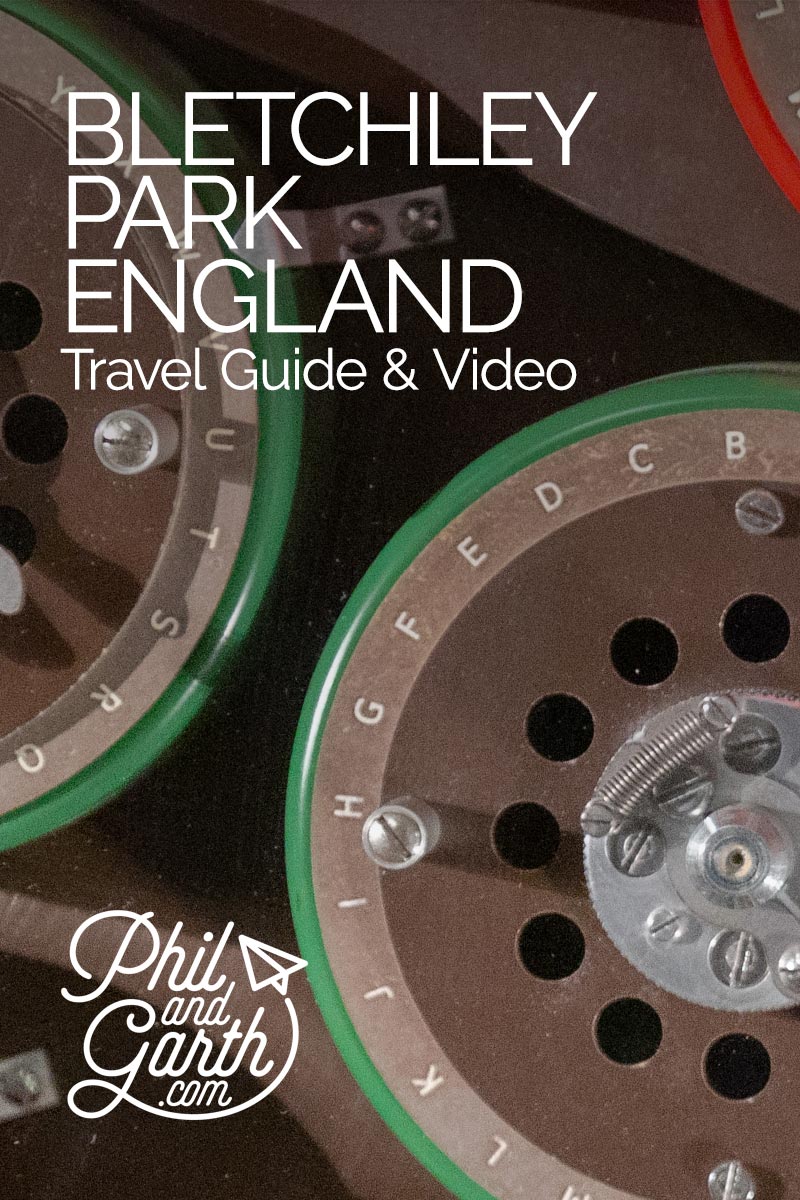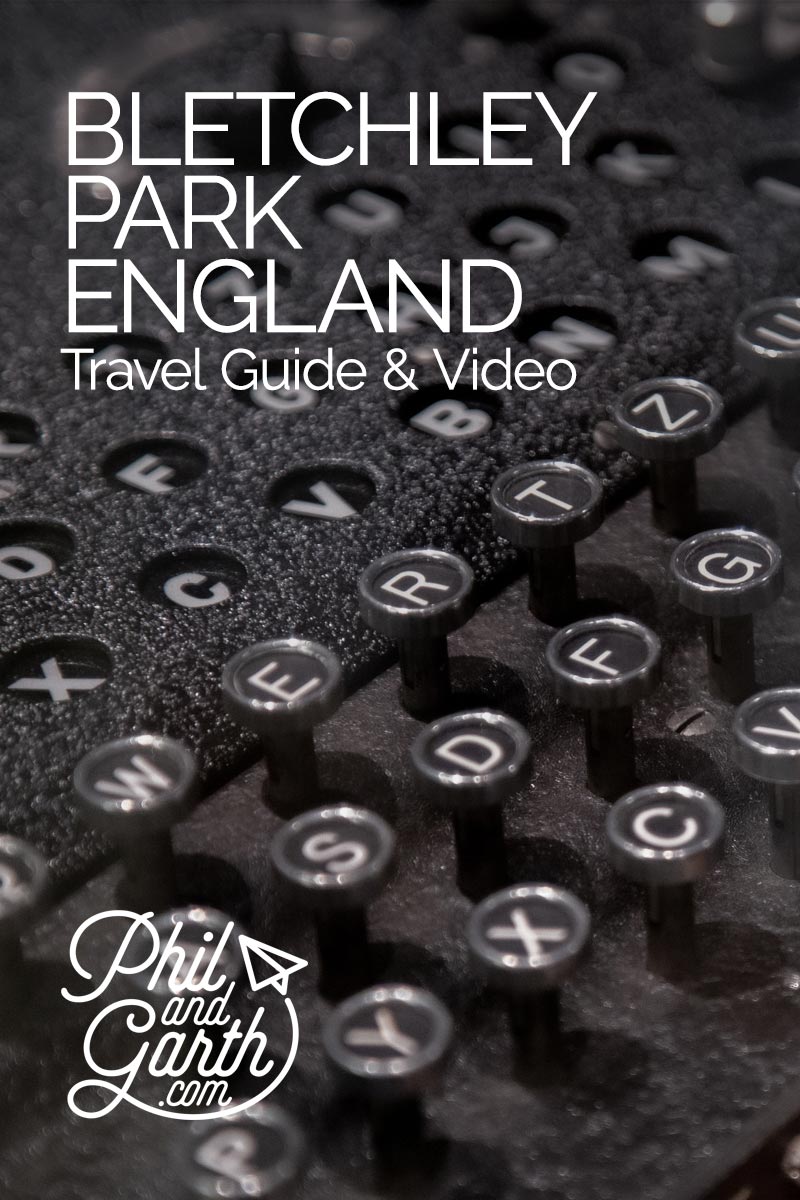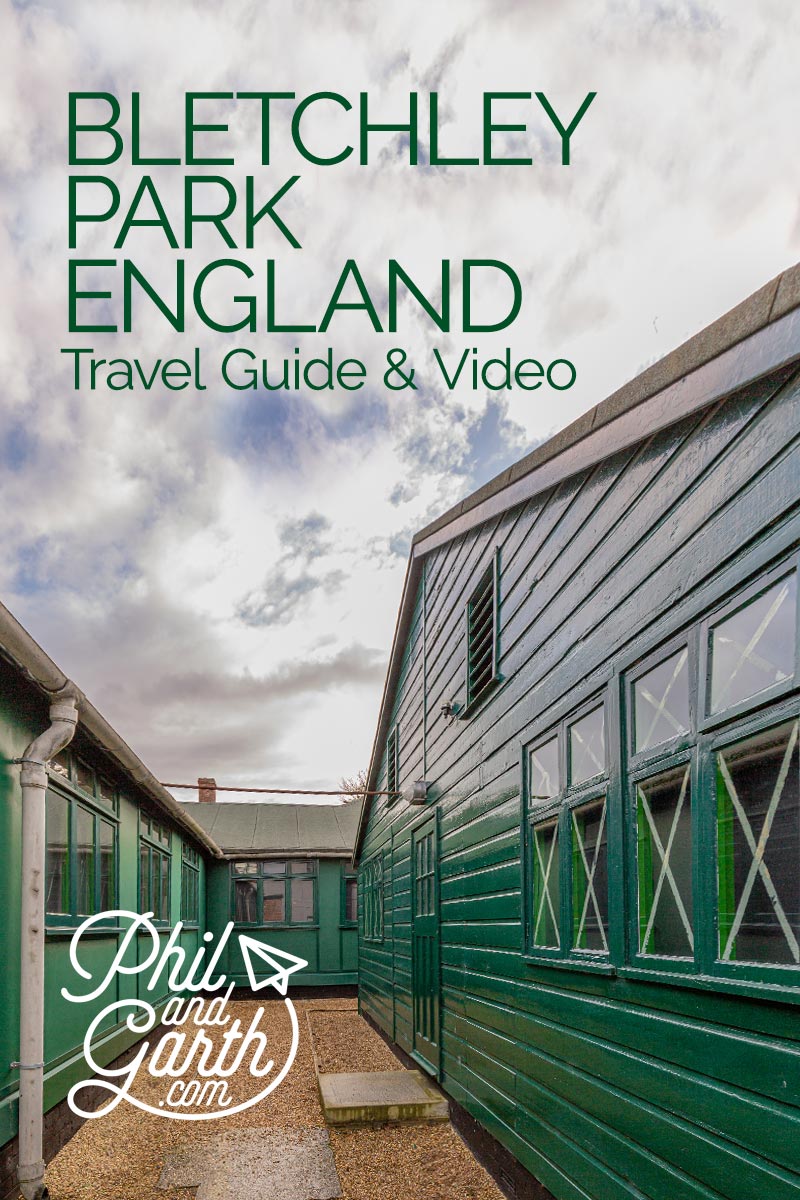Last updated: 7th January 2022
We’re both self confessed nerds, so we’ve been wanting to visit Bletchley Park to see the world’s birthplace of modern computing for a while. We finally decided on a long weekend and booked an AirBnB for the night. In this Bletchley Park travel guide we’ll show you what to see in a day exploring the world of cryptography (the art of solving codes).
Table of Contents
Home of Britain’s Secret WW2 Codebreakers
Bletchley Park was Britain’s best kept secret. A top-secret place where even the staff had no idea what their colleagues did working in the office next door. It was World War 2 and secrecy was the name of the game, everything was classified and staff had to sign the Official Secrets Act. It must have been so hard! especially not been able to tell your family. Winston Churchill said Bletchley workers were the “geese that laid the golden eggs and never cackled”.
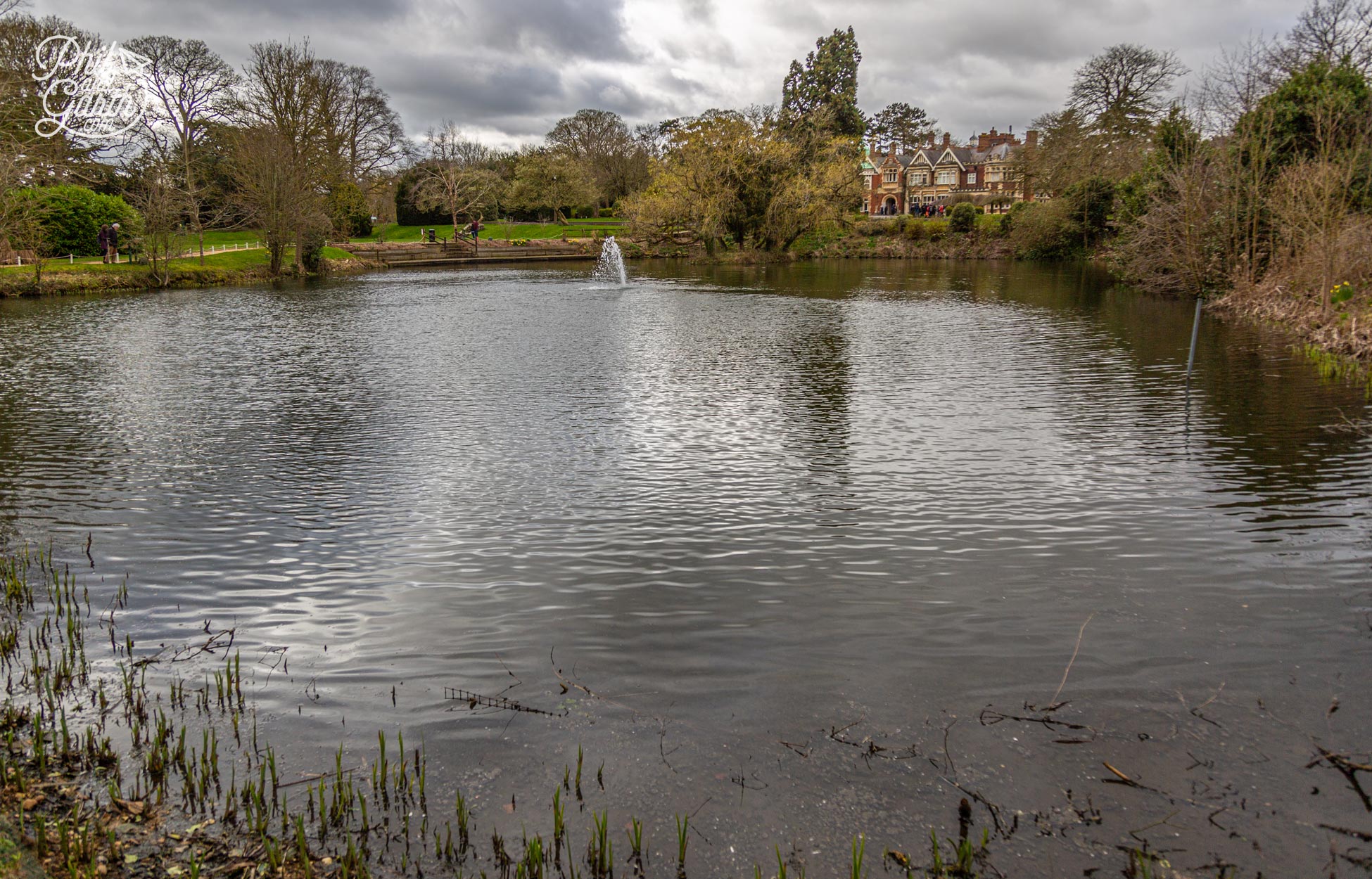
Bletchley Park’s lake and mansion, with lovely landscaped grounds
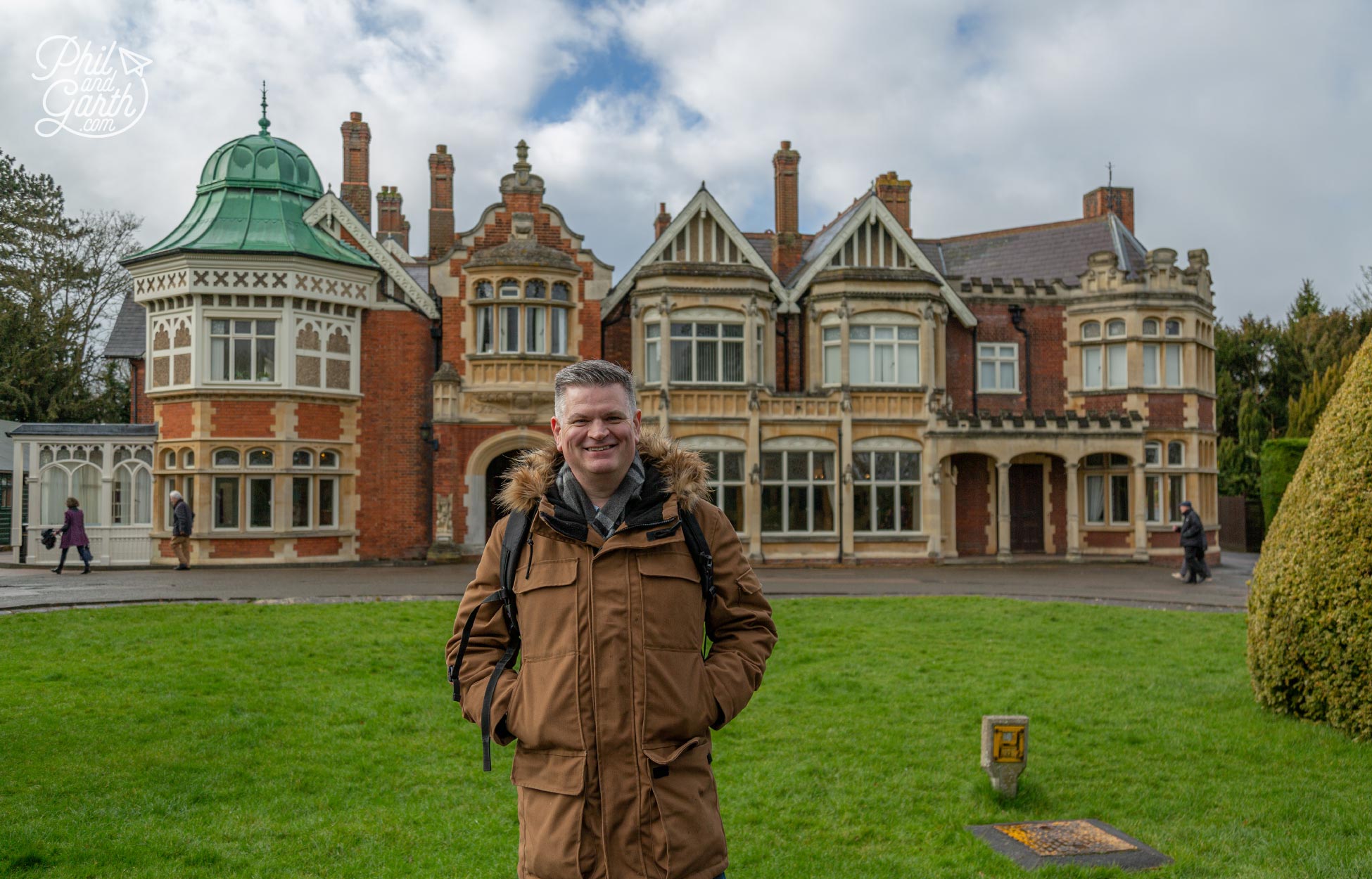
Phil outside the mansion
Bletchley Park was the home of Britain’s best codebreakers. Their most famous codebreaker was Alan Turing who along with his mathematical colleagues deciphered the code of the Enigma machine. A sophisticated machine made by the Germans to send secret encrypted military communications during World War 2. Alan Turing’s team went onto build a machine, the ‘Bombe’ which would crack thousands of daily Nazi messages. Bletchley Park played a vital intelligence role giving Allied forces one of their best weapons in fighting and winning battles during World War 2. Including The Battle of Britain, The Blitz to Battle of the Atlantic, however Bletchley’s biggest achievement was considered to be the success of the D-Day landings (more on that later). It’s estimated the codebreakers work reduced the length of World War 2 by 2 years saving millions of lives.
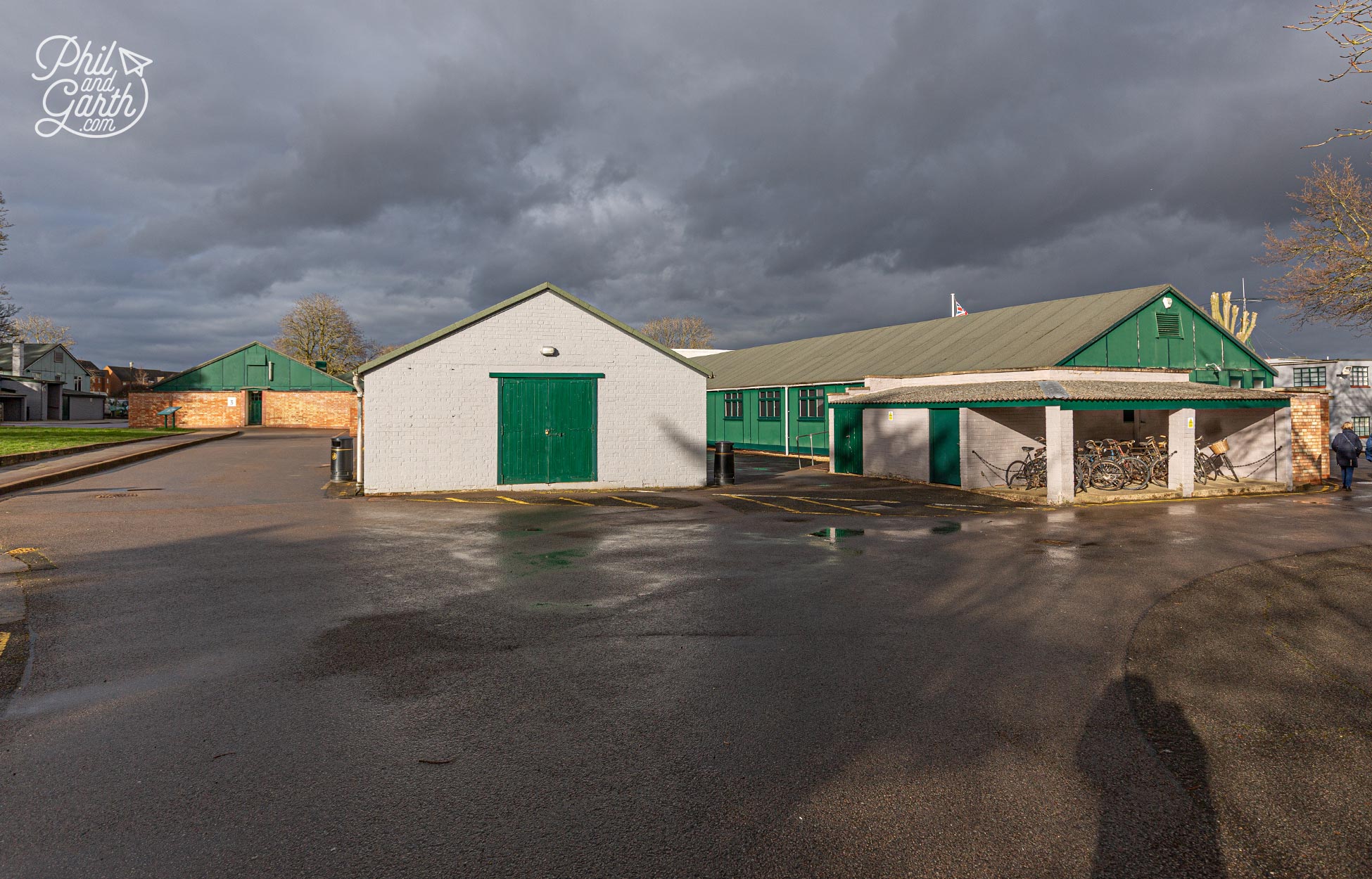
The codebreaking huts at Bletchley Park
The Beginnings of Bletchley Park – ‘Station X’
Bletchley Park is situated in Milton Keynes, 50 miles North West of London. The UK government bought the 58 acre site and mansion house at the start of World War 2 in 1938 to be the headquarters of the Government Code and Cypher School (GC&CS) and became known as ‘Station X’. The location of Bletchley Park was chosen because it was close to the GPO and the the railway line to London. More importantly its location was between Oxford and Cambridge because they hoped to attract the best talent and minds from Britain’s top two universities.
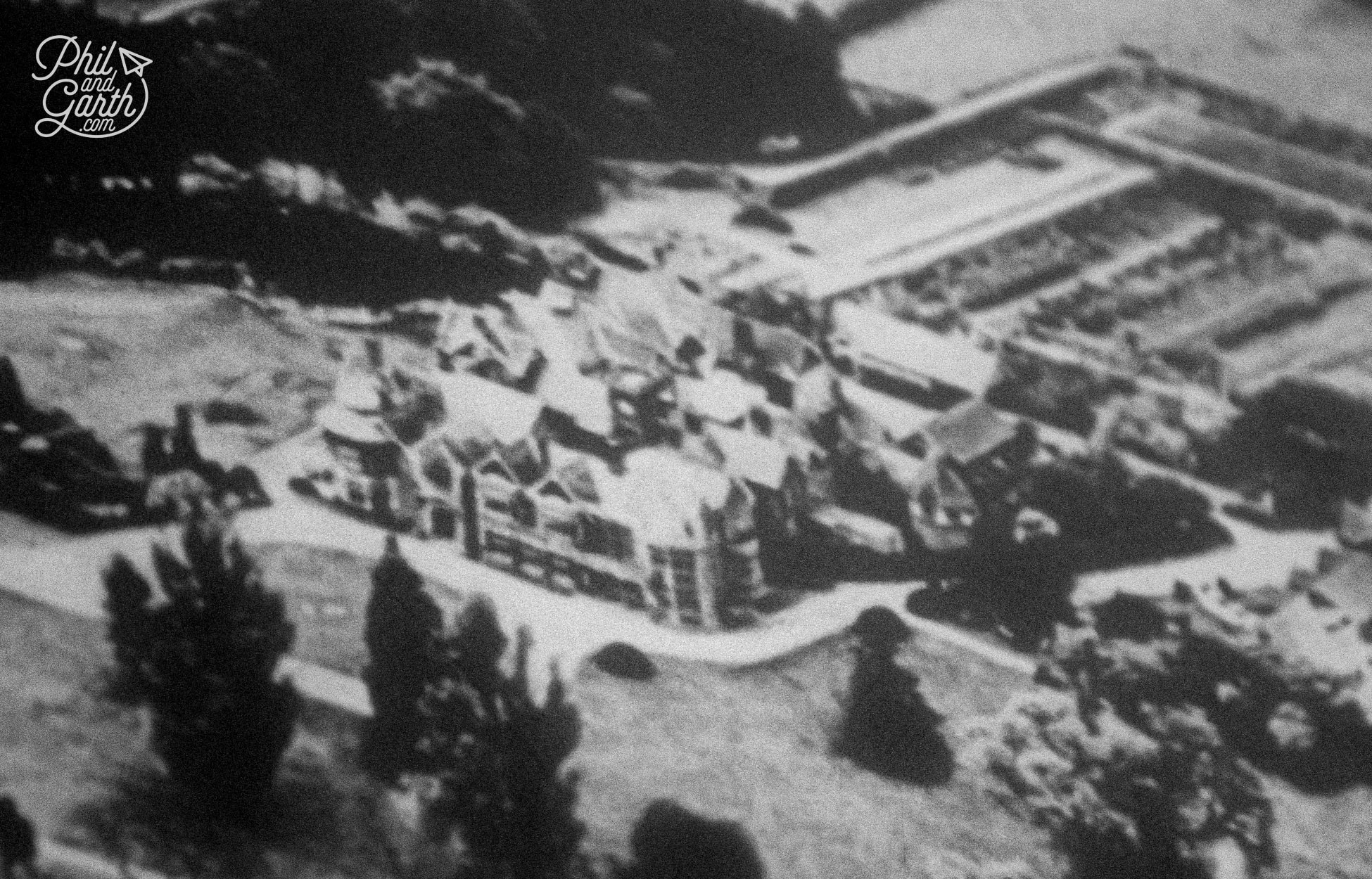
Old photographs show Bletchley was surrounded by countryside, today it’s surrounded by houses
Bletchley Park began with 200 staff and ended up with over 9,000. Experts were also recruited by solving crossword puzzles in newspapers, which was brilliantly depicted in ‘The Imitation Game’ 2014 movie starring Benedict Cumberbatch. Three quarters of the staff were female and shifts operated 24 hours a day. American military personnel were also based here. Bletchley Park was code breaking on an industrial scale by an army of intellectuals and the German Nazis had no idea!
Breaking The Enigma Code
During the day we got to see lots of Enigma machines in different exhibits. It looks just like a traditional typewriter however it used 3 rotors, to scramble messages into unintelligible text. The 3 rotors could produce 159 million million million possible combinations and these settings were reset every night at midnight. This is was what made the Enigma challenge a monumental task for Alan Turing and his team to crack. The German’s were so confident that Enigma code was unbreakable they transmitted their messages freely over the radio airwaves as morse code.
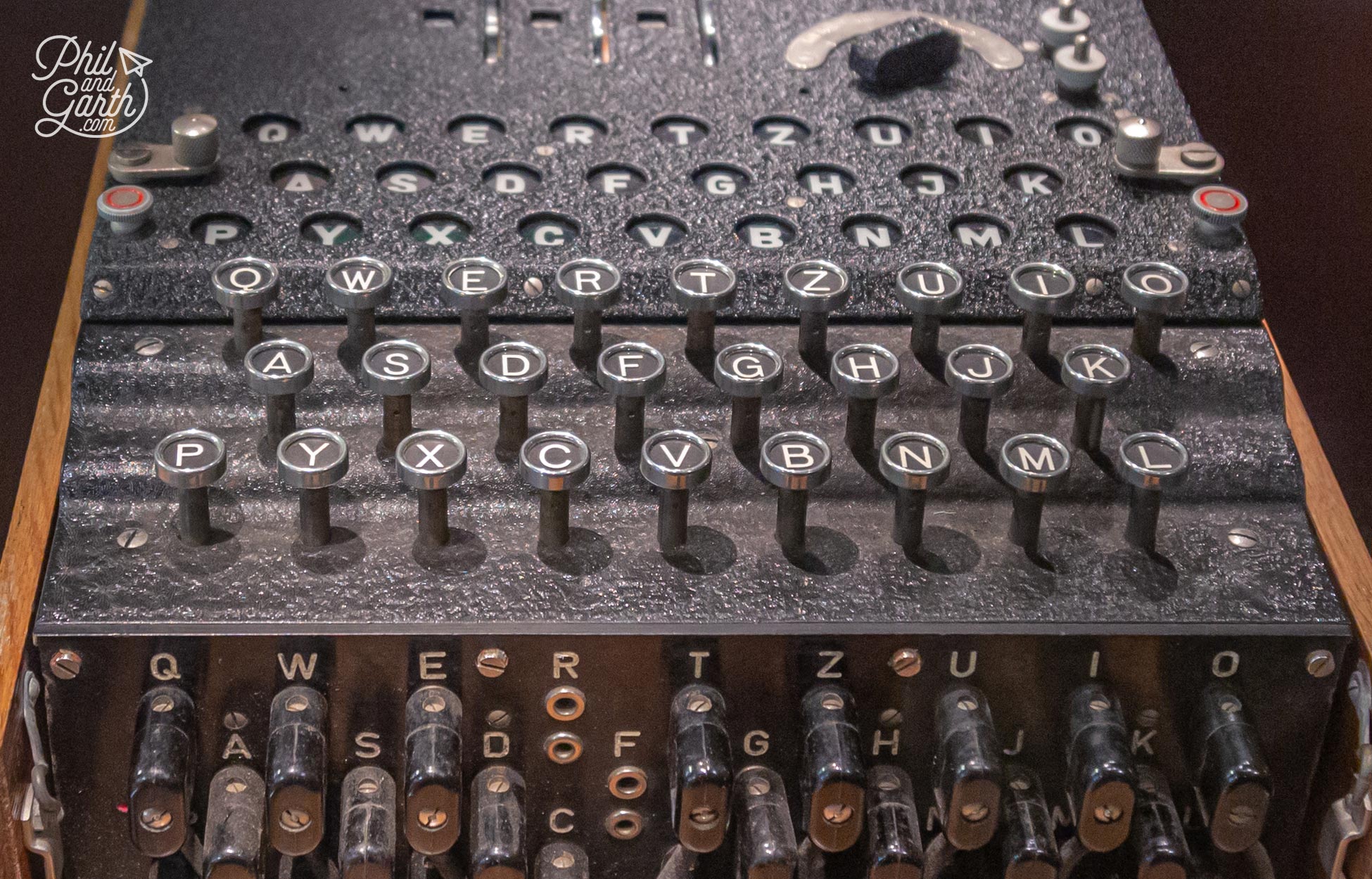
The German Enigma cipher machine
Turning’s team eventually cracked the code by using their mathematical skills and intelligence given to them in part by a team of Polish codebreakers. The Polish were also trying to crack the Enigma machine and decided to share their knowledge with the Brits just before Poland was overrun by the Nazis.
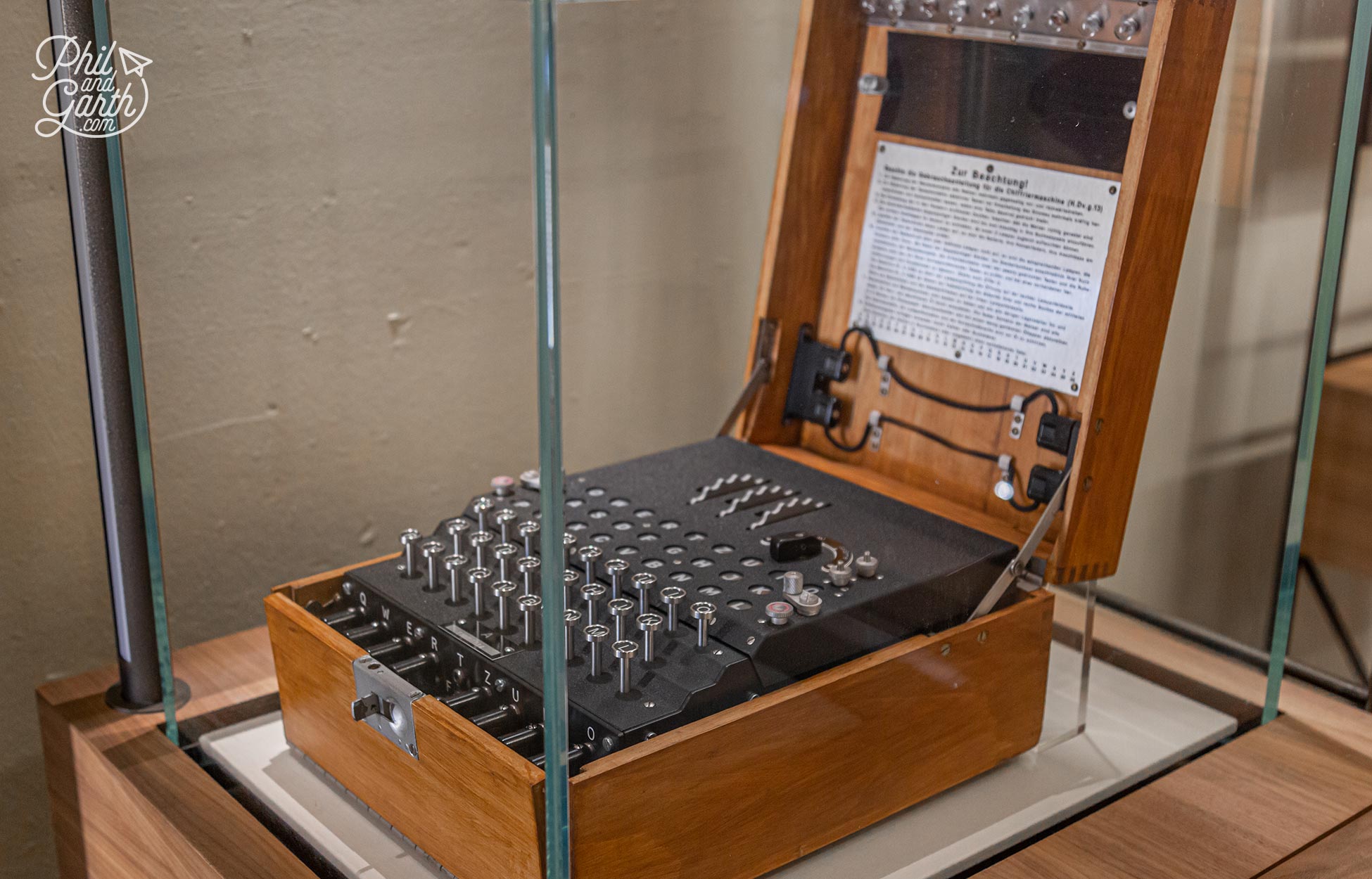
Bletchley houses the world’s largest collection of Enigma machines
A Step by Step Guide to Codebreaking at Bletchley Park
Our visit to Bletchley Park started in Block-C at the Visitor’s Centre where a step-by-step guide brilliantly breaks down this really complicated subject of codebreaking. We both thought it’s an excellent exhibition and loved all the short films and interactive exhibits for adults to try!
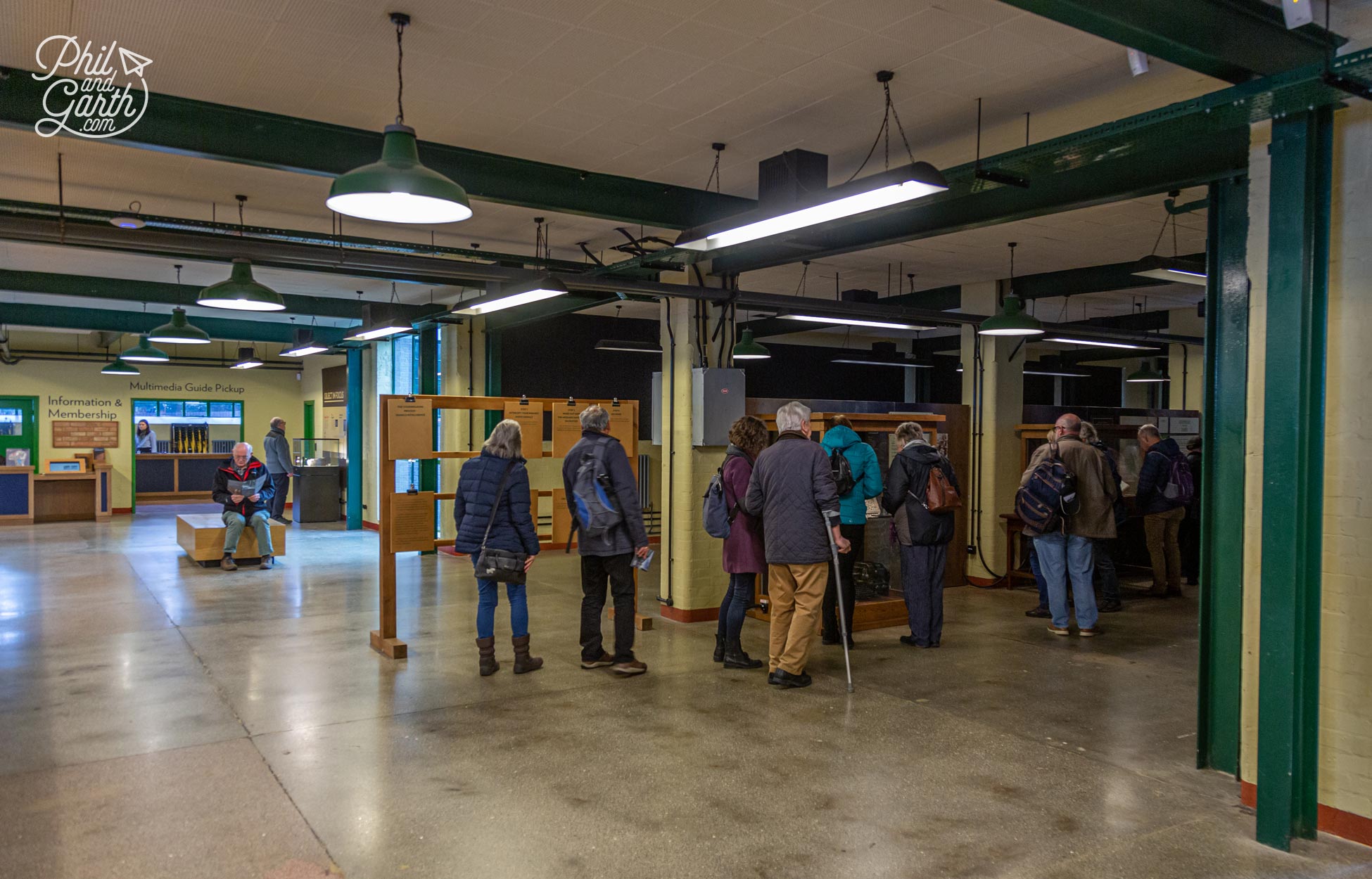
The Visitor Centre in Block C – which used to house an index card system of every message that came into Bletchley
Step 1 – Intercepting Enemy Messages
The British Military had a series of listening stations called ‘Y Stations’ across the south of England. This is where staff would listen in and intercept the Nazi morse code messages broadcast over the airwaves. Up to 3,000 were written down everyday and sent by despatch motorbike riders to Bletchley Park to decipher. They would later be sent by teleprinter.
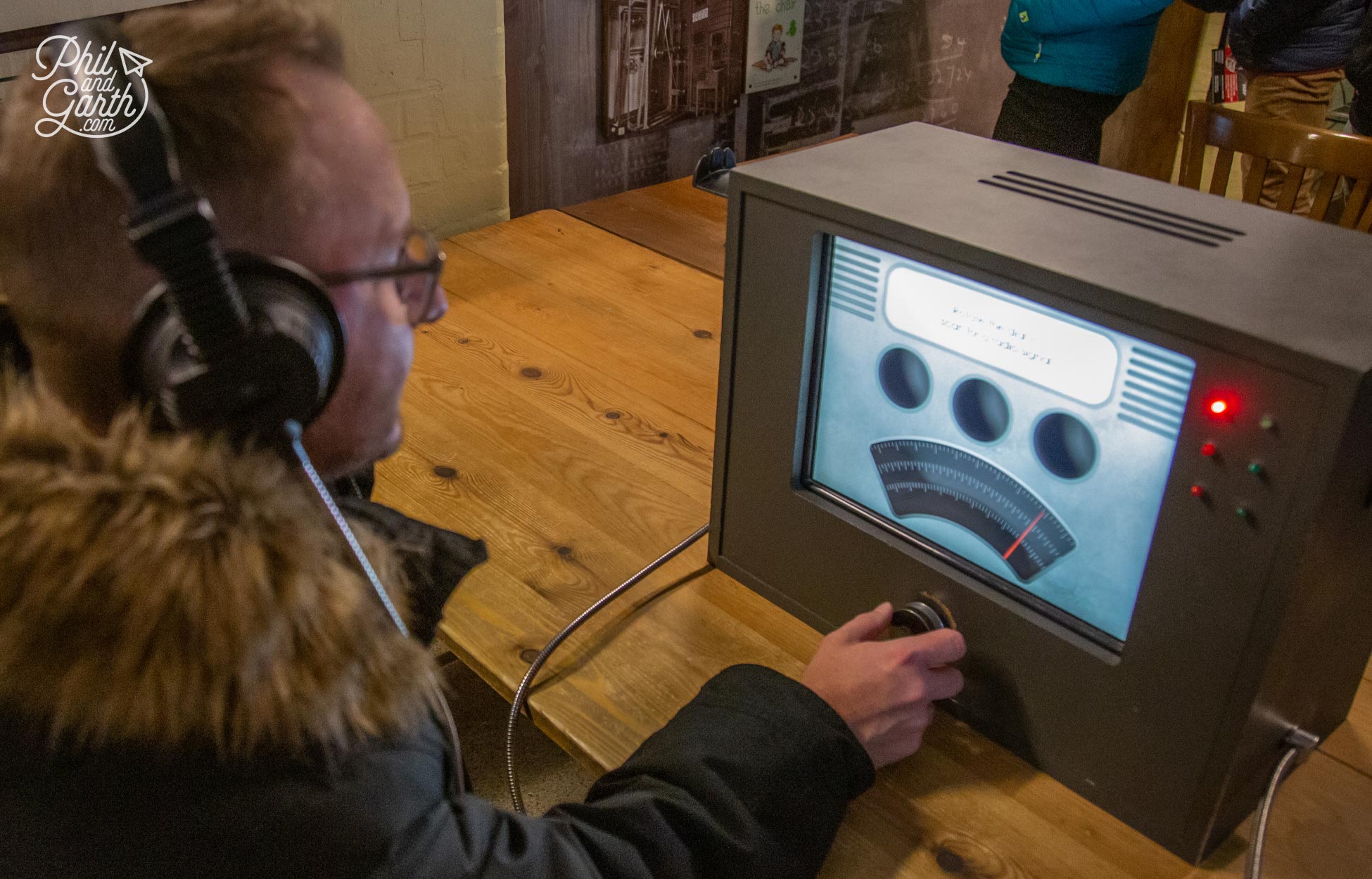
Garth tried his hand at intercepting morse code messages
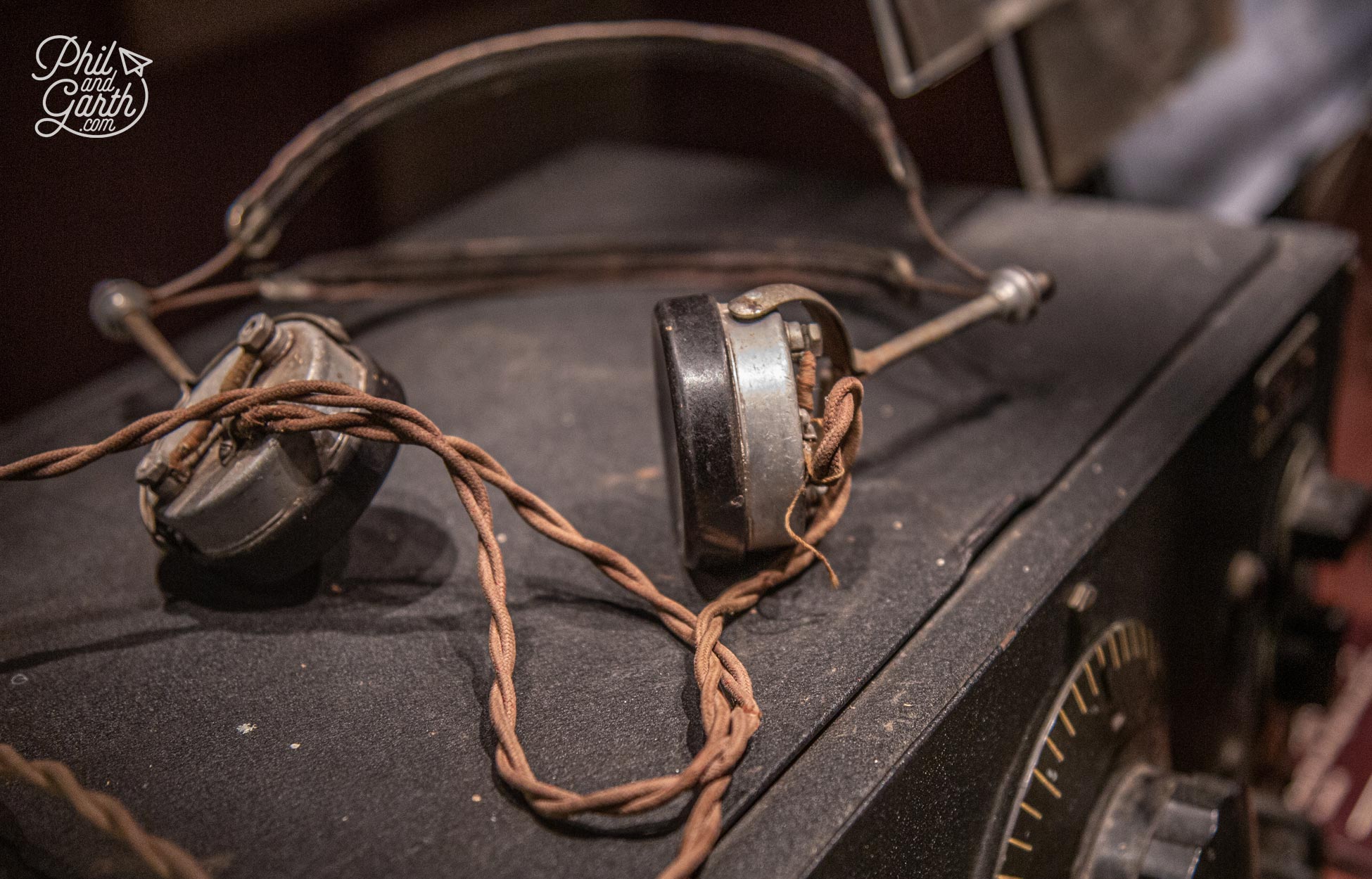
An old pair of headphones used for listening to morse code
Step 2 – Breaking the Cipher
The next step was deciphering Enigma messages and was the most difficult part. The messages sent to Bletchley were ciphered – meaning they were scrambled into different letters and numbers. For example the words “You attack at dawn” could be scrambled into “BPYFW WGZXG QSVRP”. In order to decipher the messages they had to work out what settings had been used on the Enigma machine that day to encrypt the messages. The work was tedious and labour intensive.
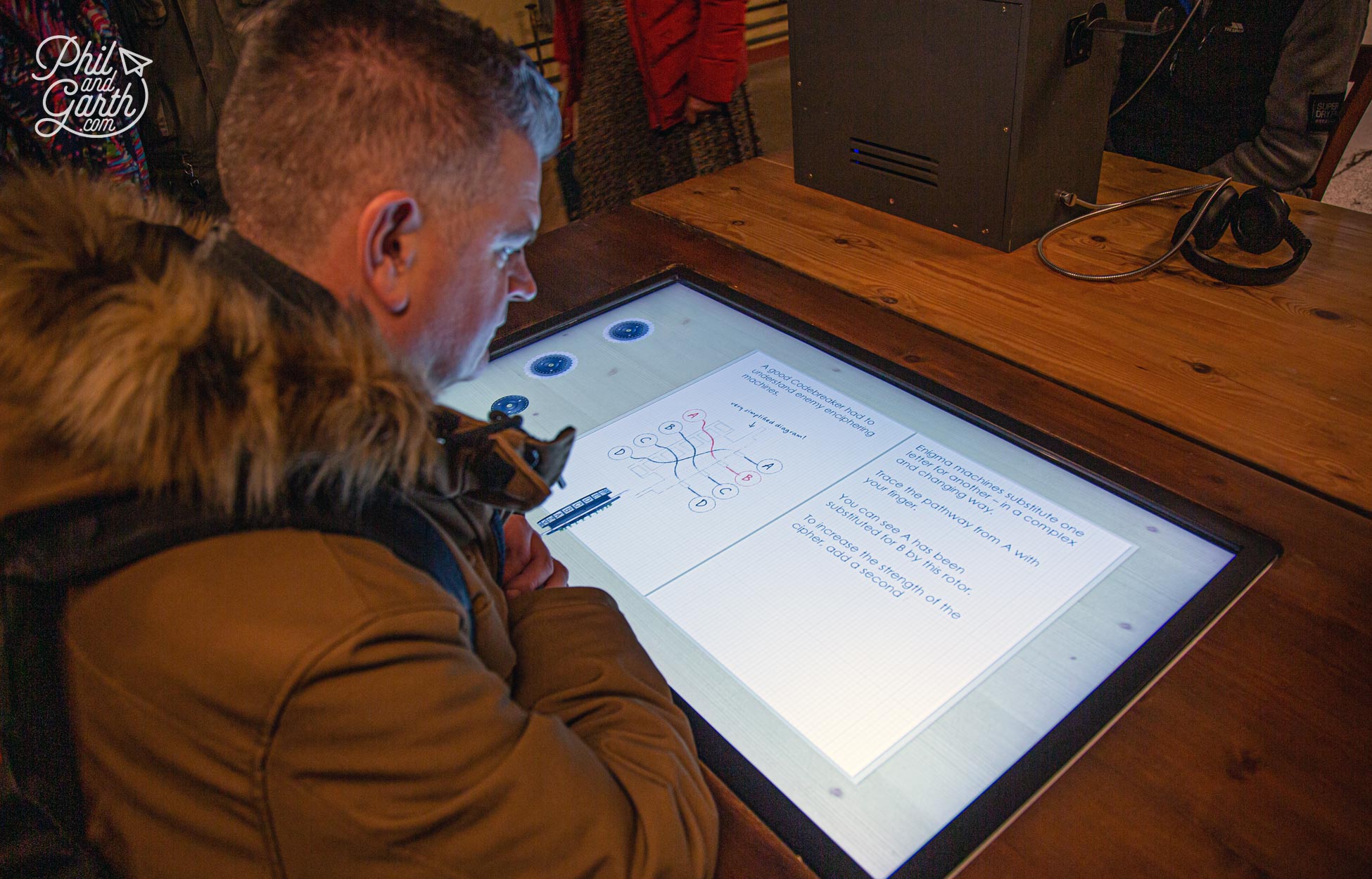
Phil learning how to decipher a message from Enigma
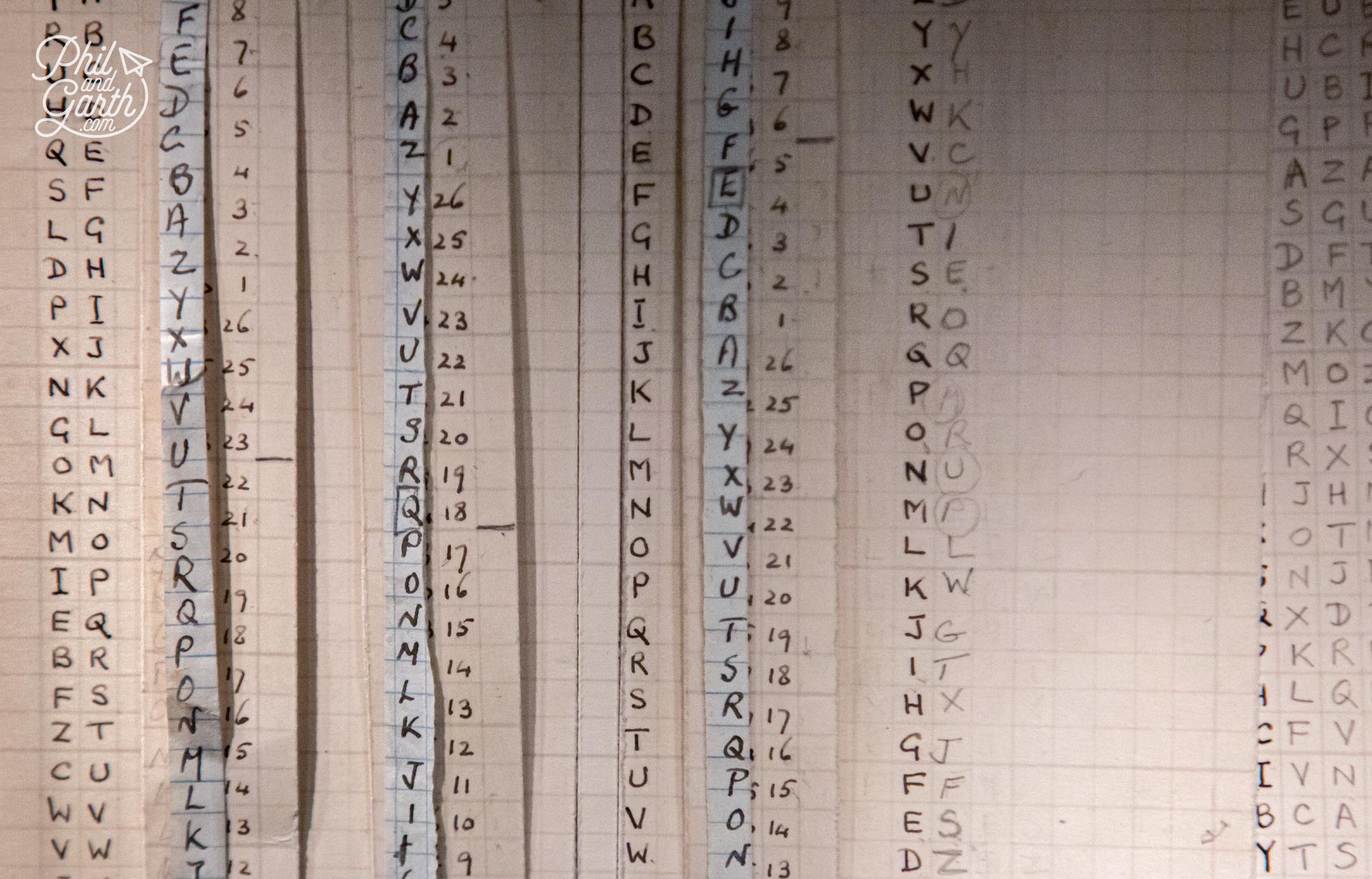
Deciphering Enigma messages
Step 3 – Making Sense of Nonsense
Once a message had been deciphered, codebreakers knew the settings of the Enigma machine for that day. These daily settings were then input into on a Typex machine. Each ciphered message was typed out and a deciphered message (usually in German) came out of the machine on a long piece of paper.
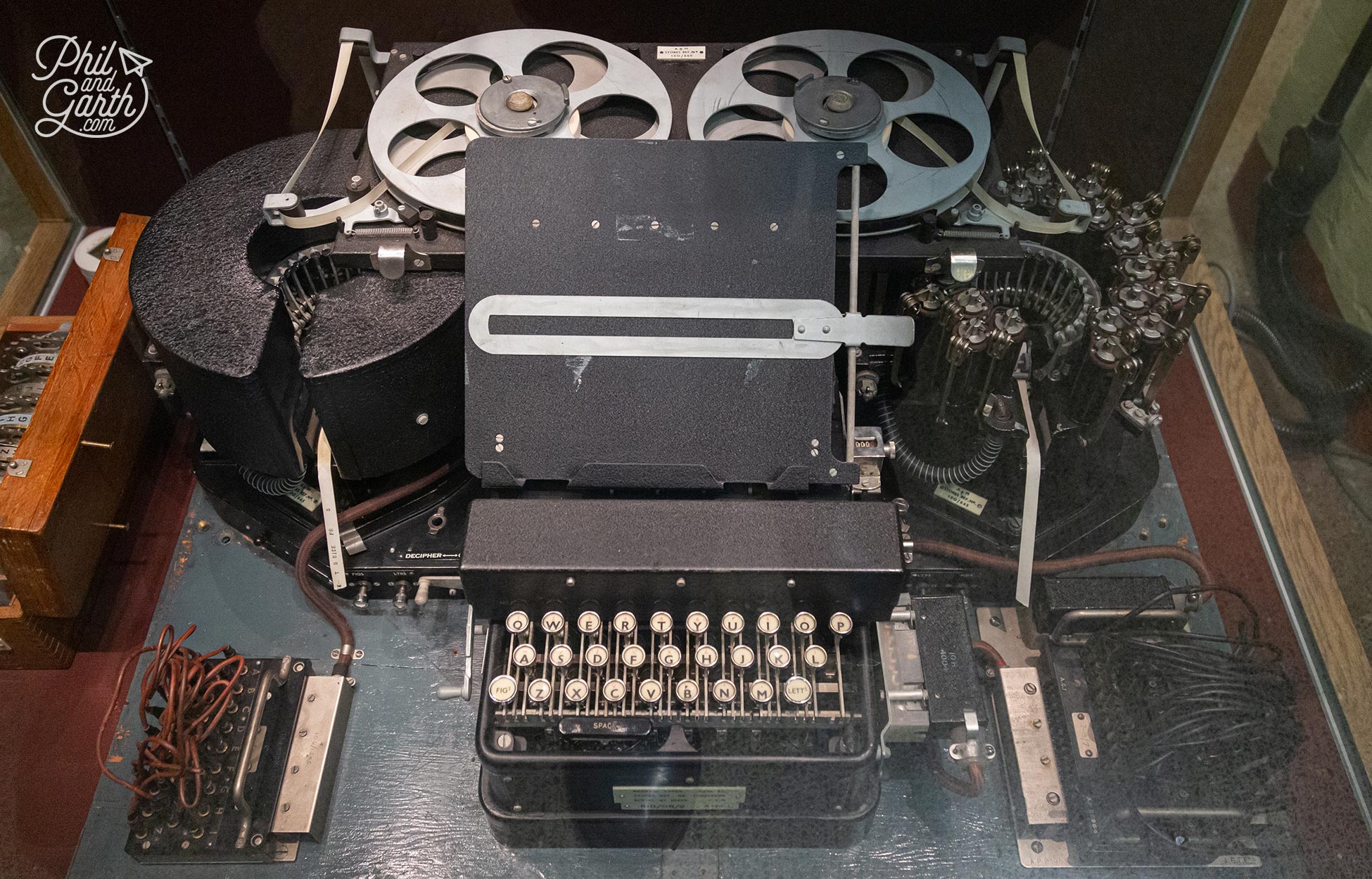
An original Typex machine used to decipher messages
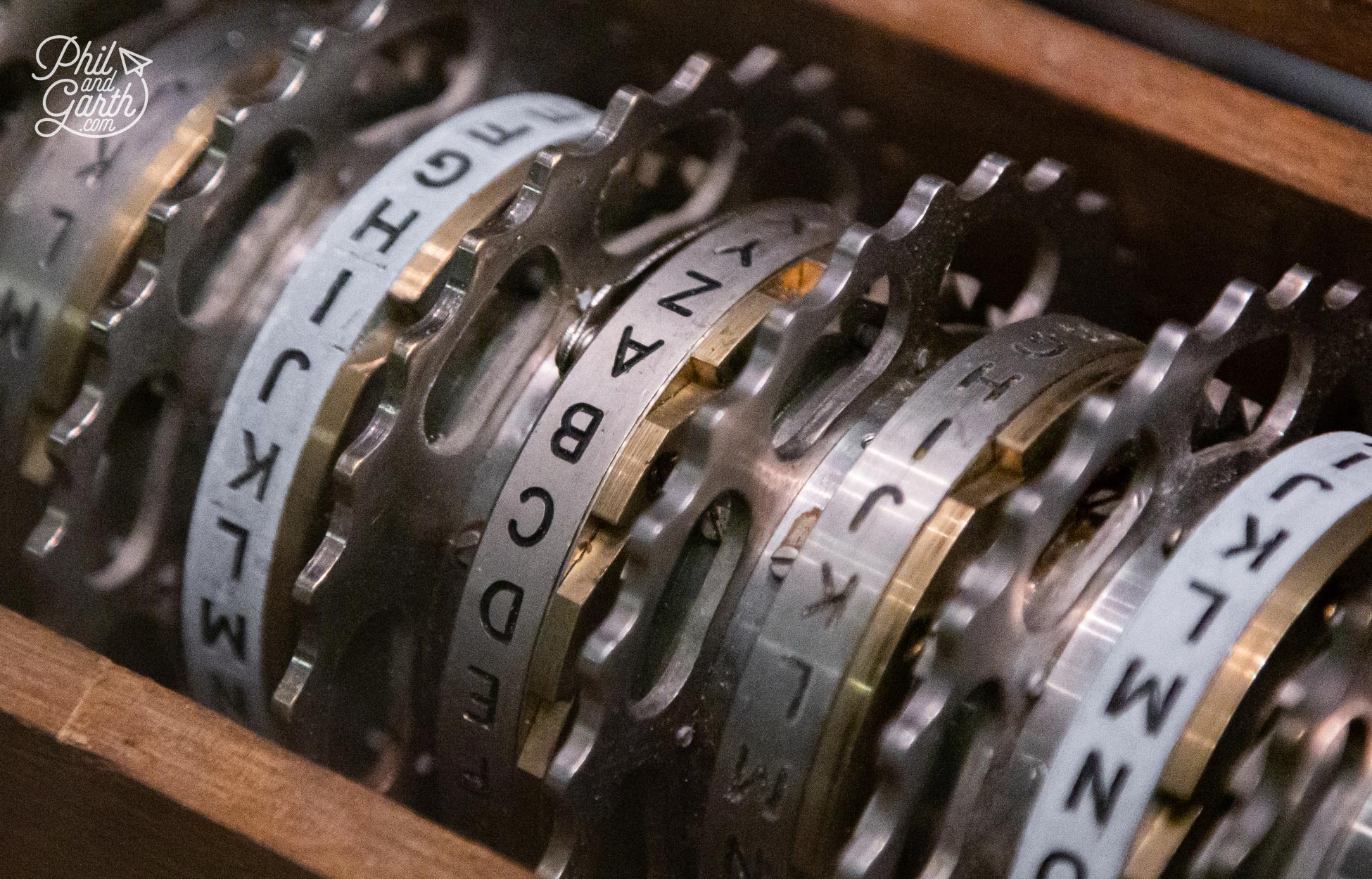
A drum key spindle used on the Typex machine
Step 4 – Translation
The deciphered messages would then need translating from German and other languages. The Enigma machines were also used by the Japanese and Italian military. The Nazis had Axis powers – a coalition of other countries like Japan and Italy. So a team of translators had to translate lots of languages into English.
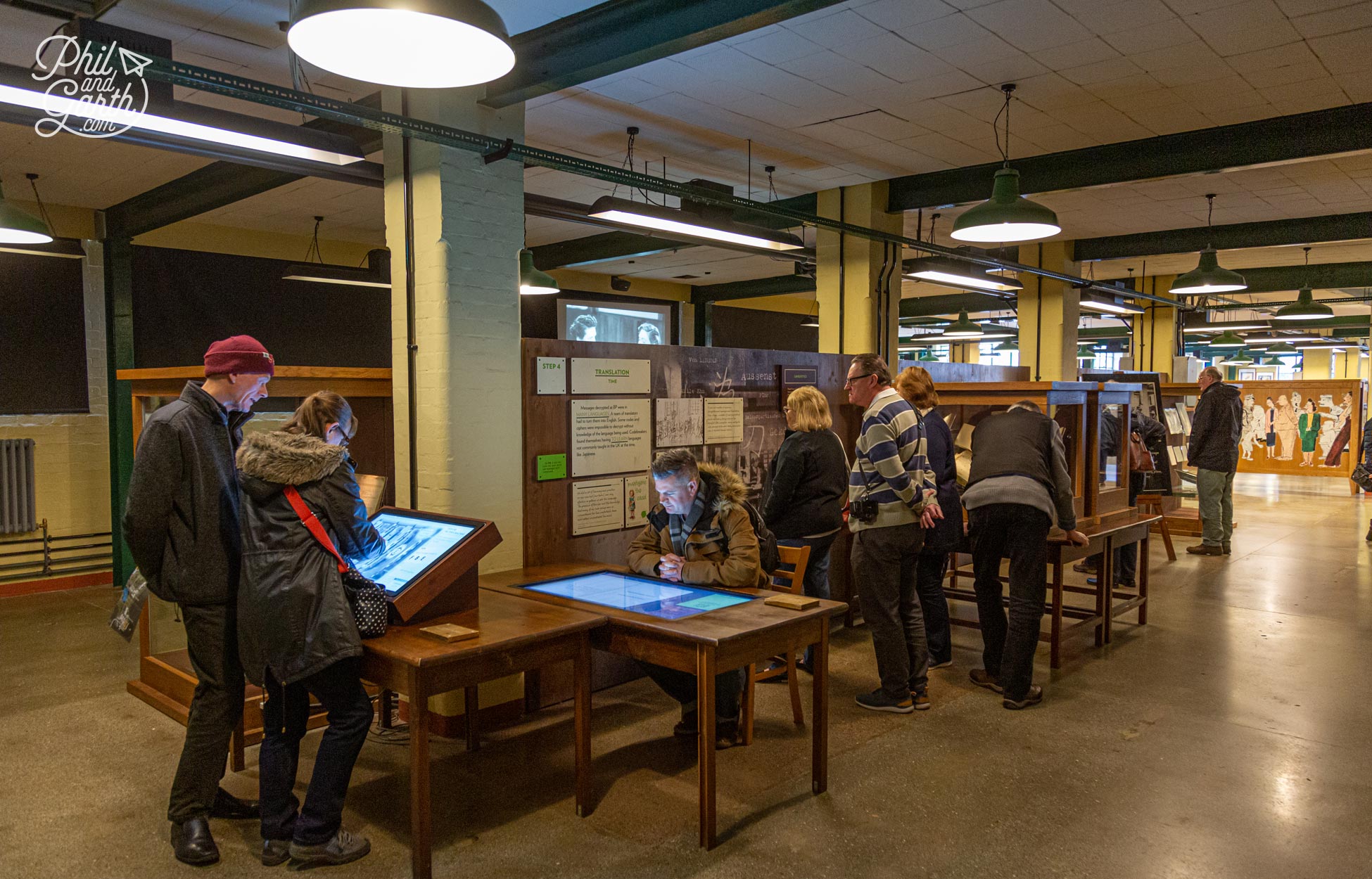
Phil learning about Step 4 translating messages
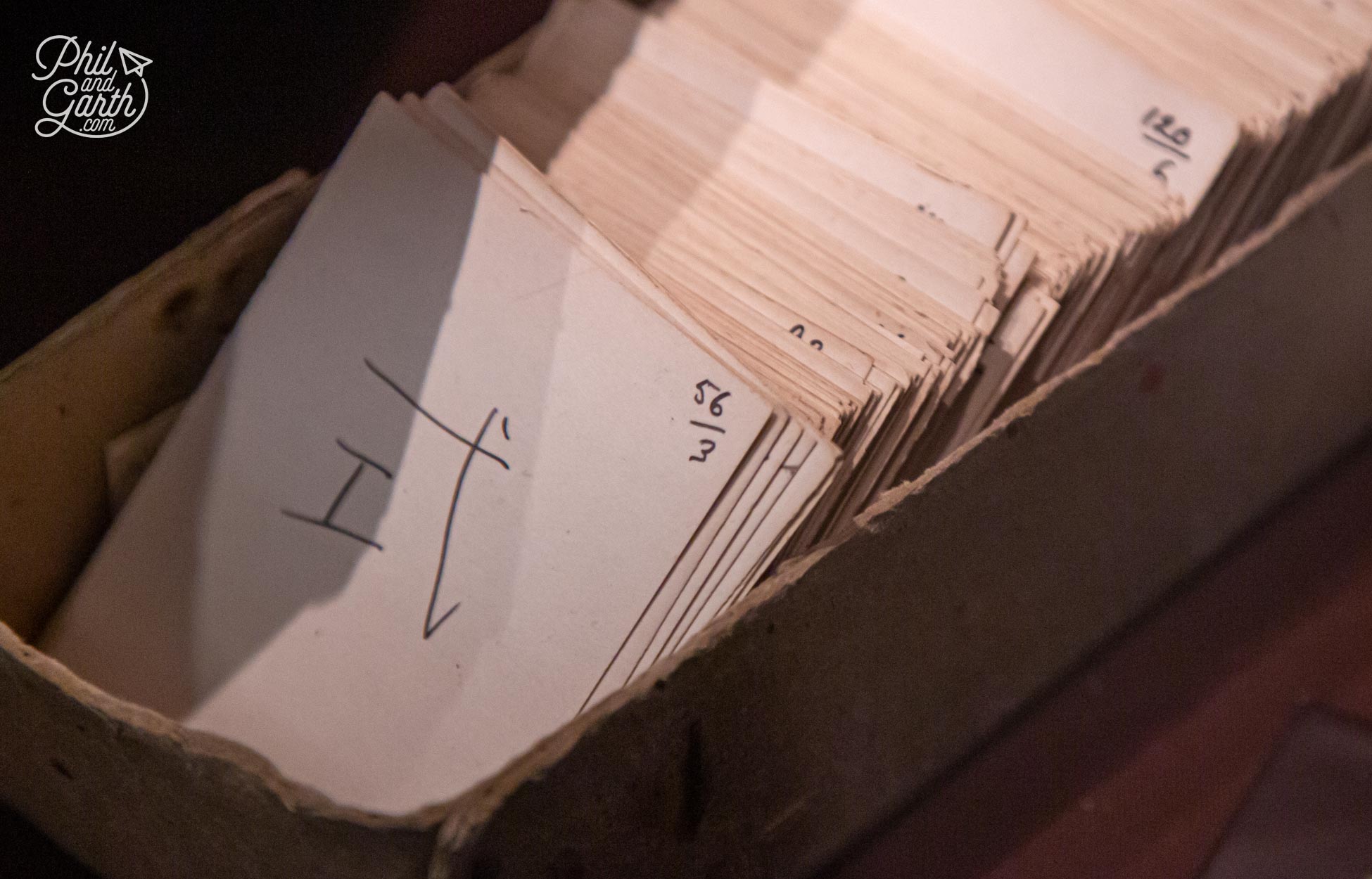
A box of Japanese characters
Step 5 – Have We Seen Anything Like This Before?
The next step was cross referencing the messages, to see if anything matched.
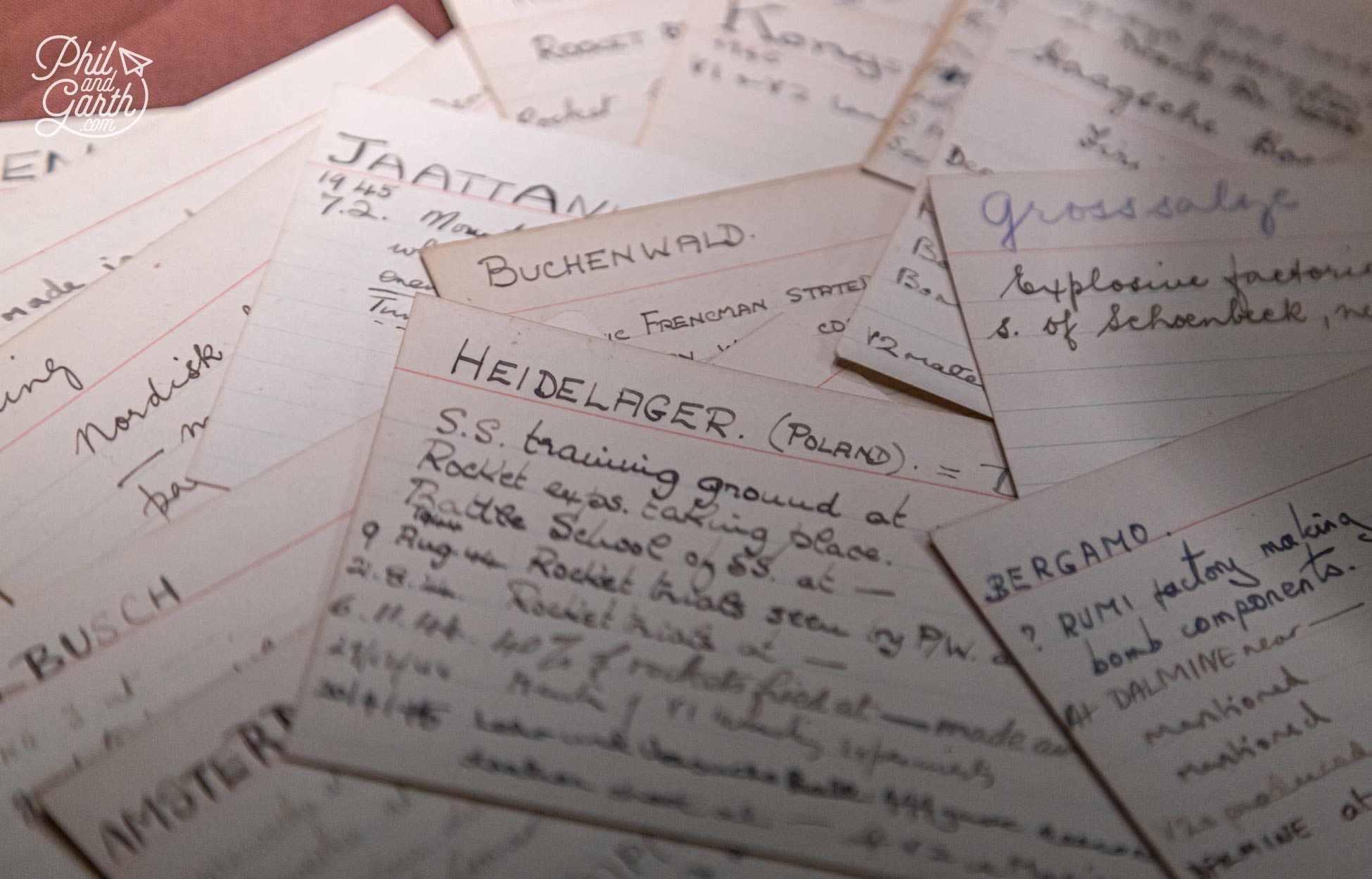
Index cards were used to cross reference messages
Step 6 – Sending On The Intelligence
Finally the top-secret intelligence was delivered under lock and key to Allied commanders and the Prime Minister Winston Churchill. Codenamed Ultra, the intelligence was made to look like it had come from spies. It was essential to prevent Nazis from discovering their Enigma messages had been broken.
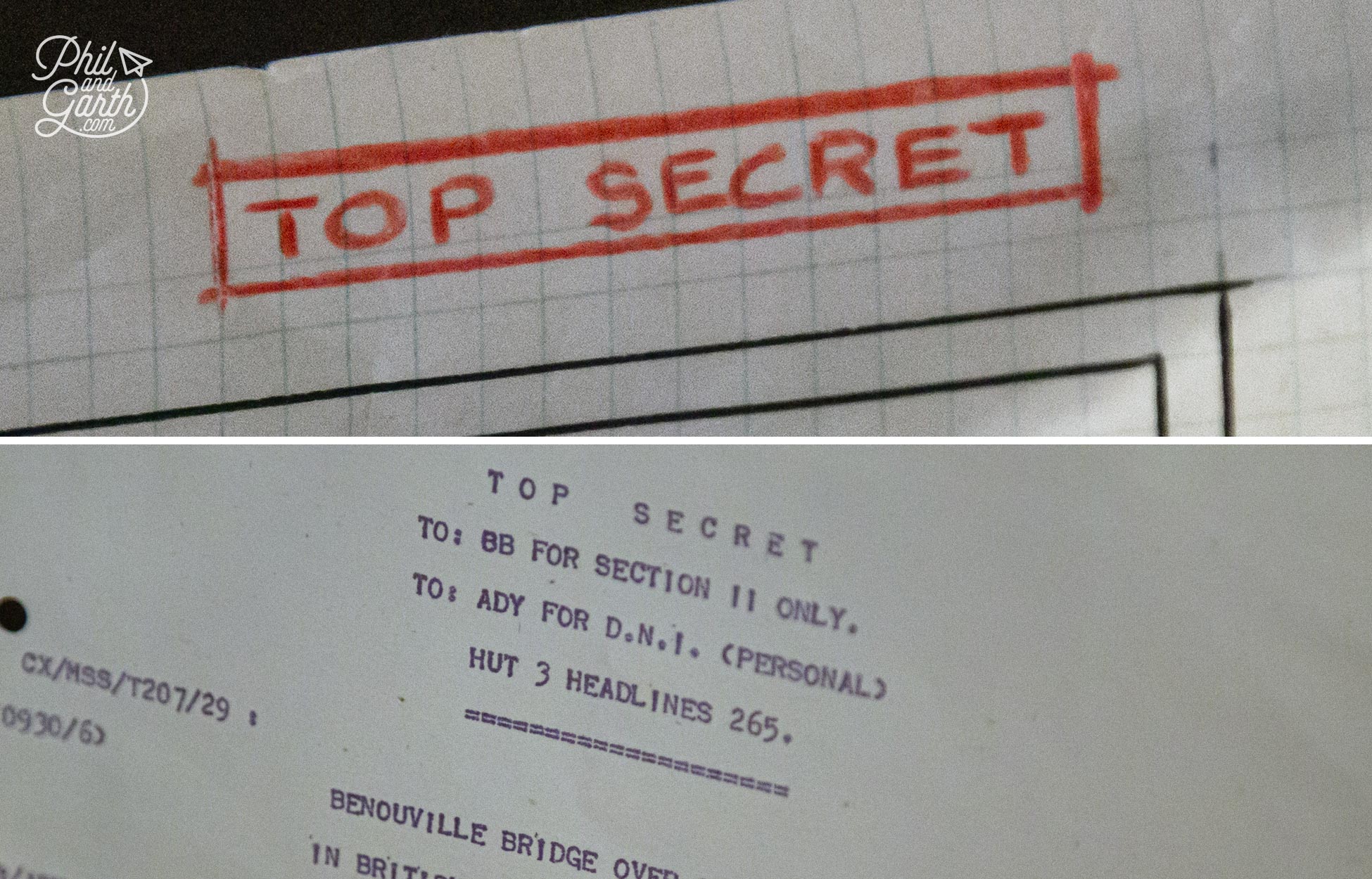
Top secret intelligence
The Famous Codebreaking Huts
As Bletchley Park grew in size, wooden huts were built to accommodate more codebreakers. Most of the huts survived but lay derelict for years, until a National Lottery grant meant they could be fully restored. Walking through the huts put everything we had seen in the step-by-step guides into context. Now we could feel what it was like to have worked inside the huts. The interiors are very basic, which is exactly what they were like – practical working spaces with no luxuries. Even the blinds were closed over the windows, so you couldn’t see into the next hut.
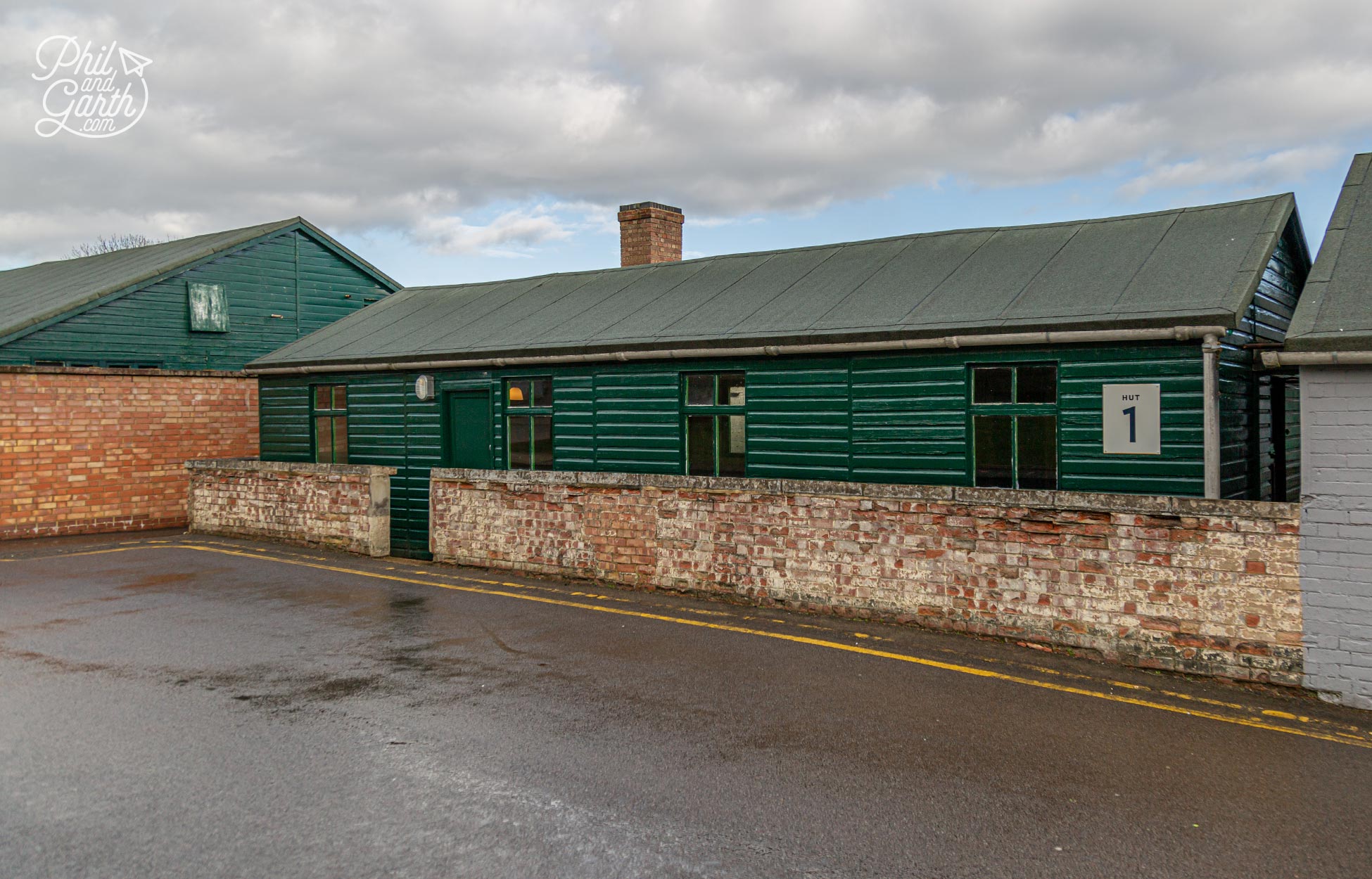
The exterior had simple brick walls to provide the huts with some protection against a bomb blast
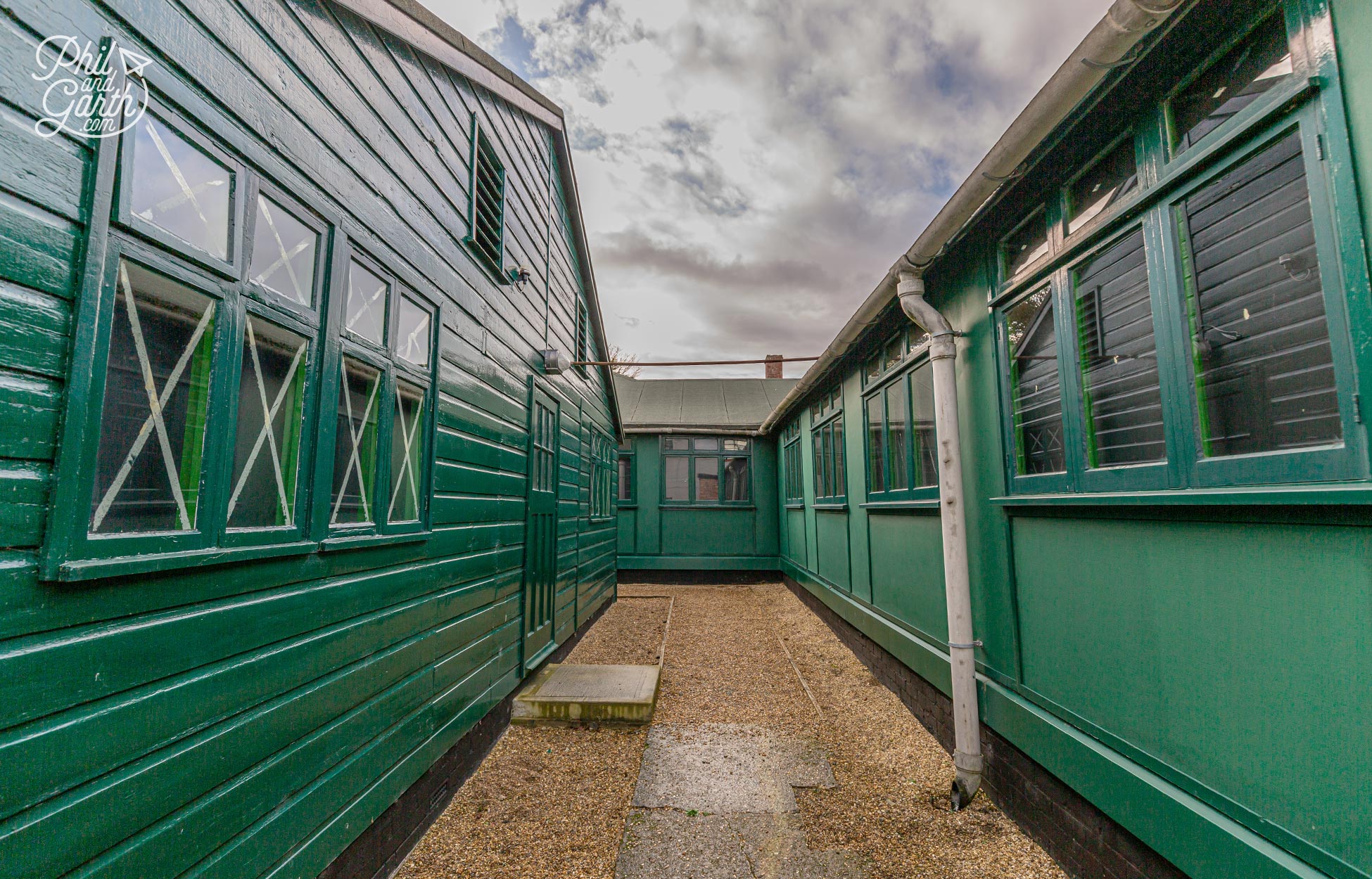
Exploring the areas around the huts
Hut 1 – Where ‘Victory’ was tested
Inside Hut 1 is where the first Bombe machine was tested. It was called ‘Victory’ and not ‘Christopher’ as depicted in The Imitation Game movie. Hut 1 would later became the transport office.
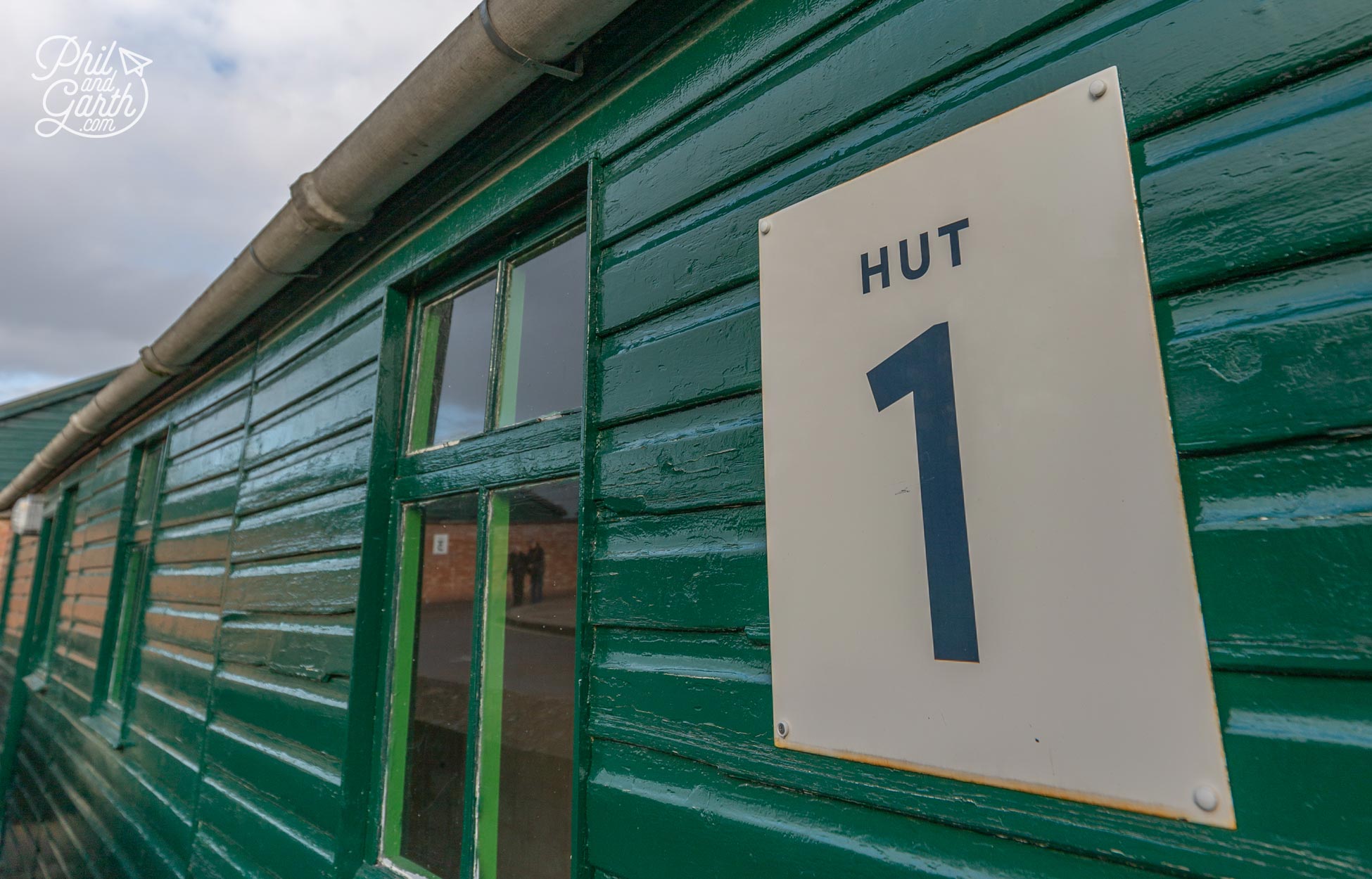
Hut No.1 – The transport office
Hut 3 – Where Messages Were Translated
In Hut 3 analysts and translators processed the messages that Hut 6 had deciphered. Lots of paper messages were passed between these two huts, so to stop them getting wet they built a wooden chute between the huts. Trays of messages were pushed to each other using a broom handle!
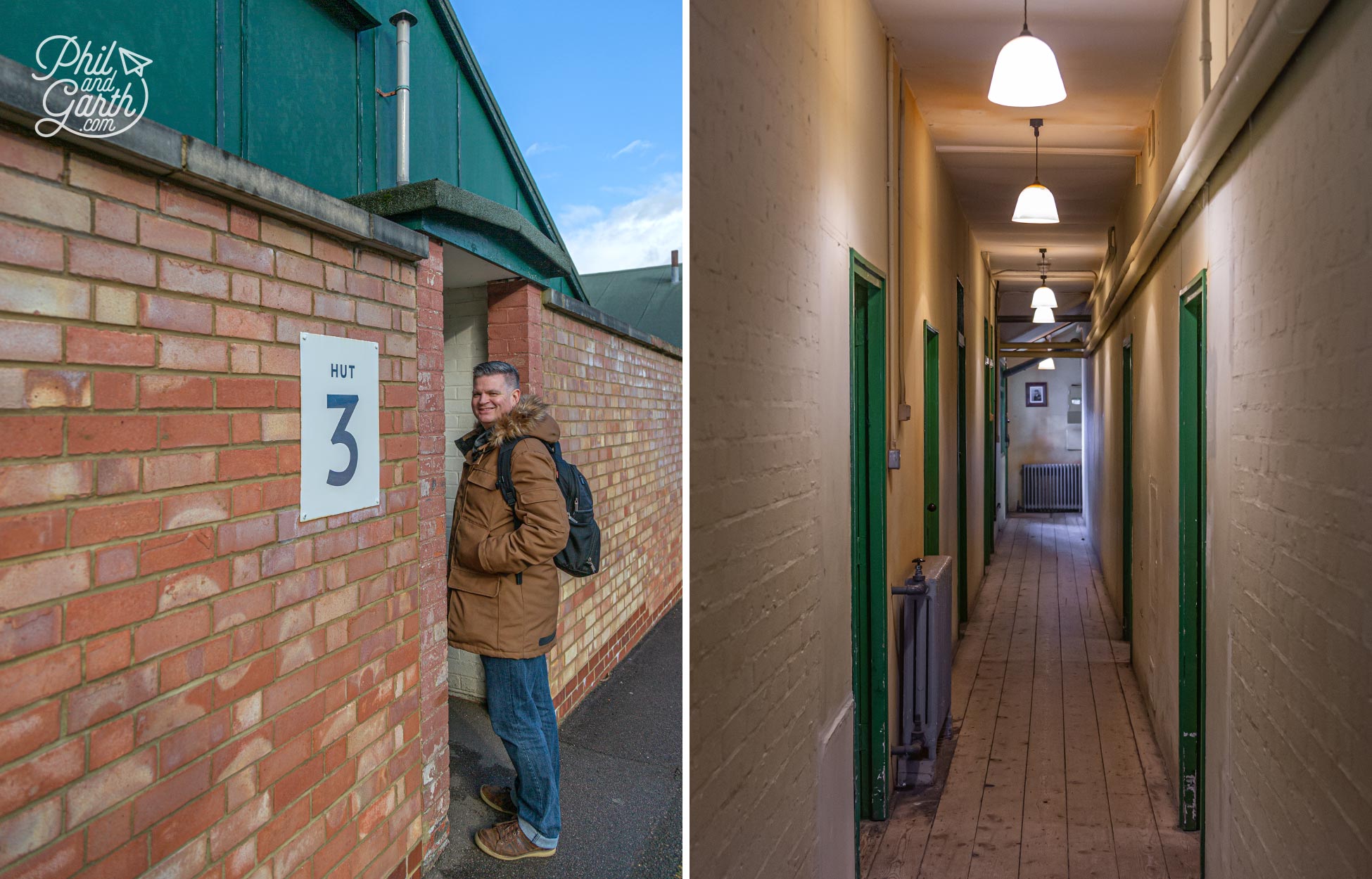
Phil outside Hut 3
Every room has been fantastically restored and sympathetically dressed with furniture and props. Special touches like jumpers left on the backs of chairs makes it look like someone has just popped outside for a cigarette. Bletchley have done a wonderful job creating an atmosphere that whisks you back in time to the 1940s.
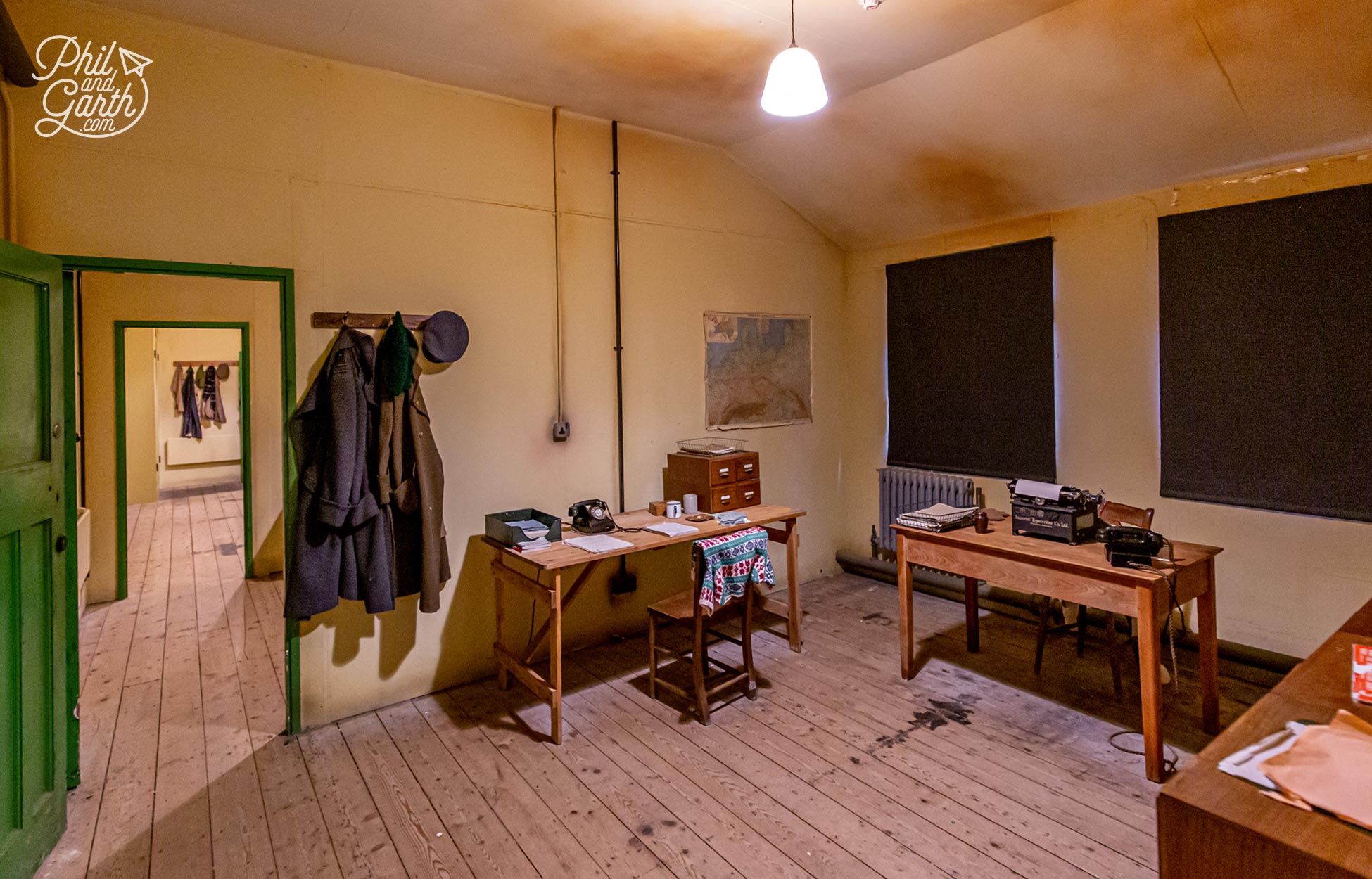
One of the rooms inside Hut 3
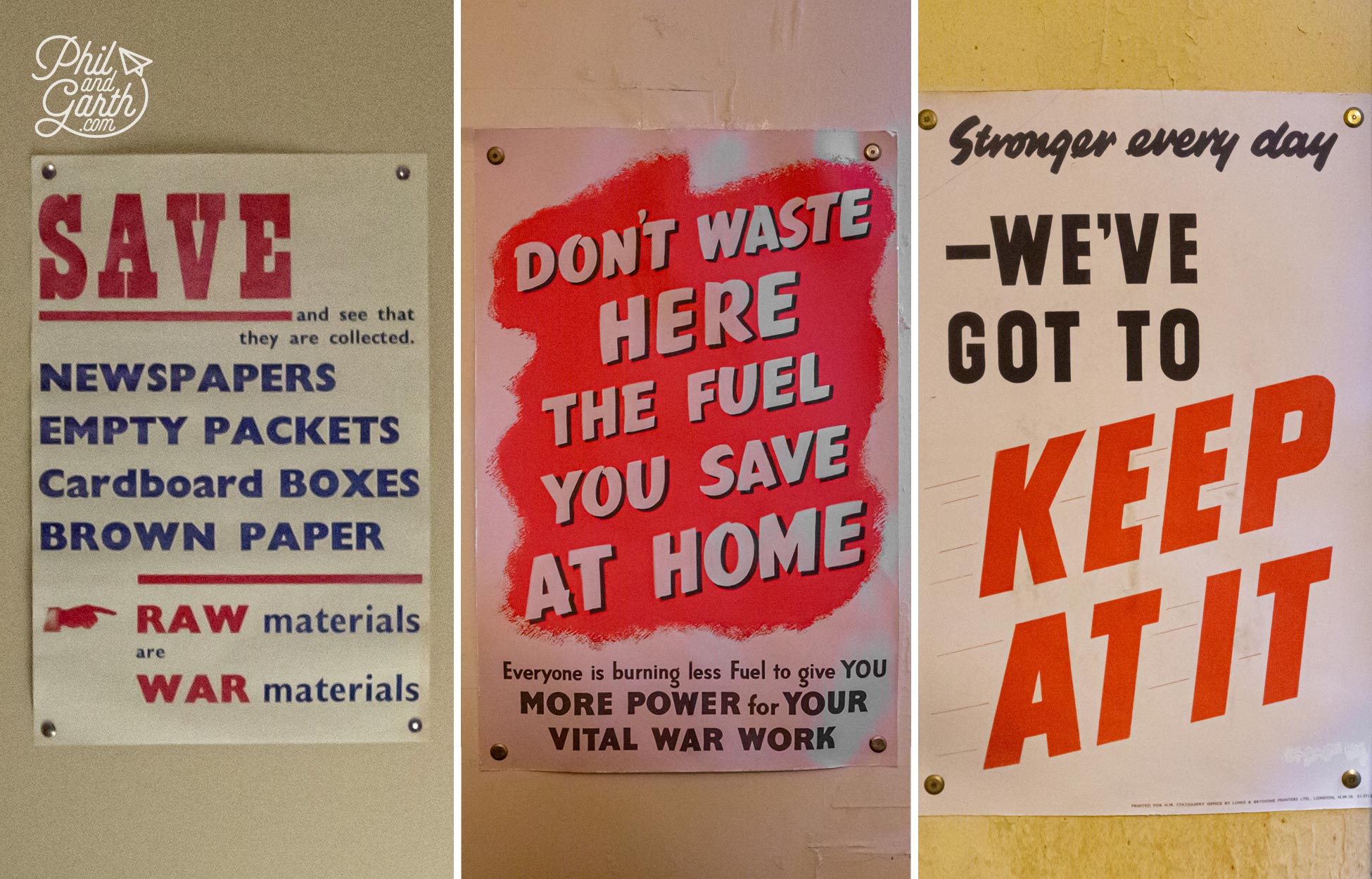
Old World War 2 posters on display
Hut 4 – The Coffee Shop
Hut 4 is next to the mansion is where they translated and analysed the deciphered naval messages from Hut 8. It is now the Bletchley Park cafe where you can book in for afternoon tea if you fancy it.
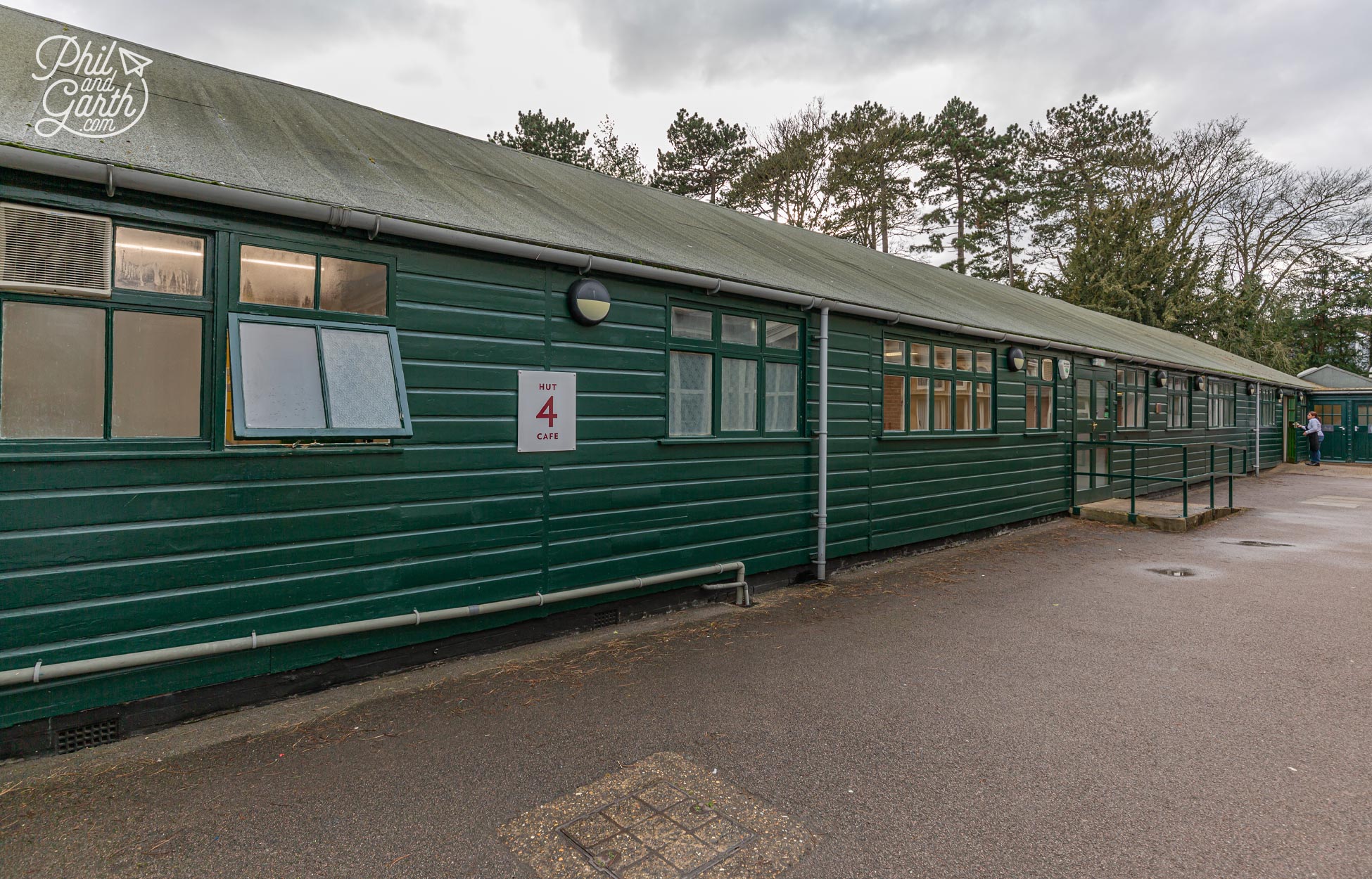
Hut 4 is now the cafe
Hut 6 – Used to Decrypt Messages
Inside Hut 6 is where the German Army & Air Force Enigma messages were decrypted. There are video images projected on the walls, they are somewhat ghostly but make the huts come alive again with the sights and sounds of people who might have worked here.
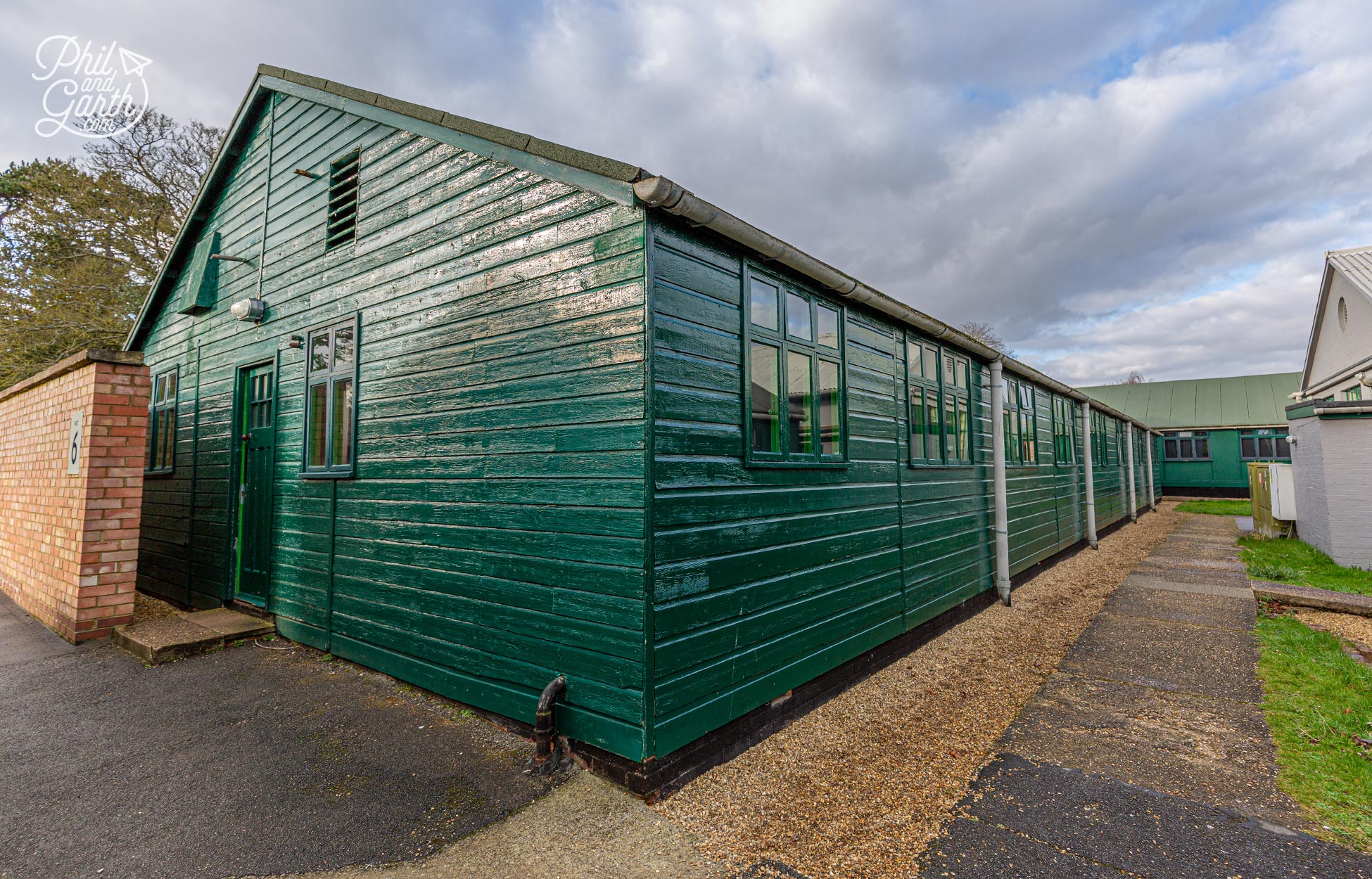
Hut 6 was considered the most important hut
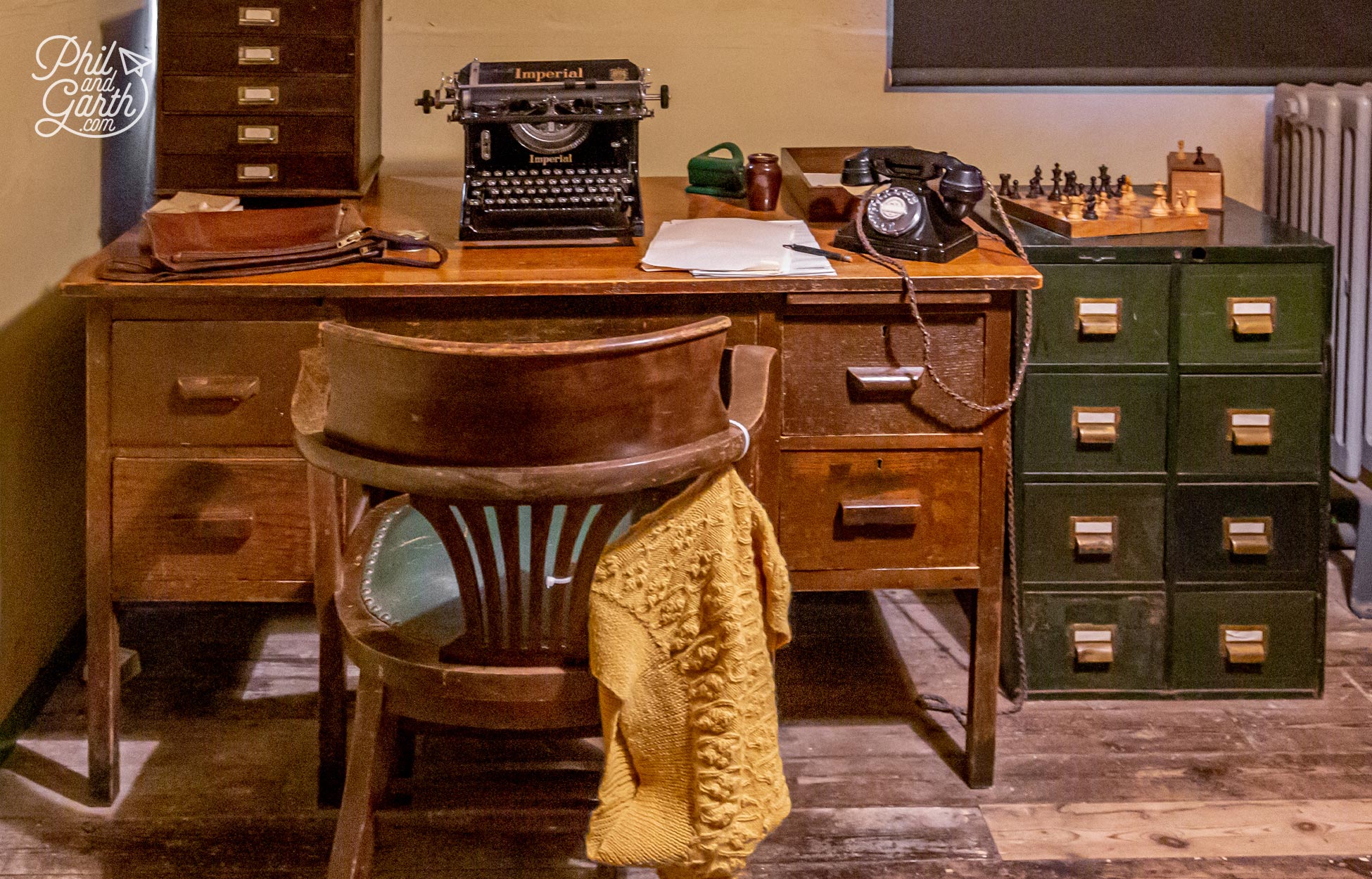
A desk is dressed inside Hut 6 as it would have been during the war
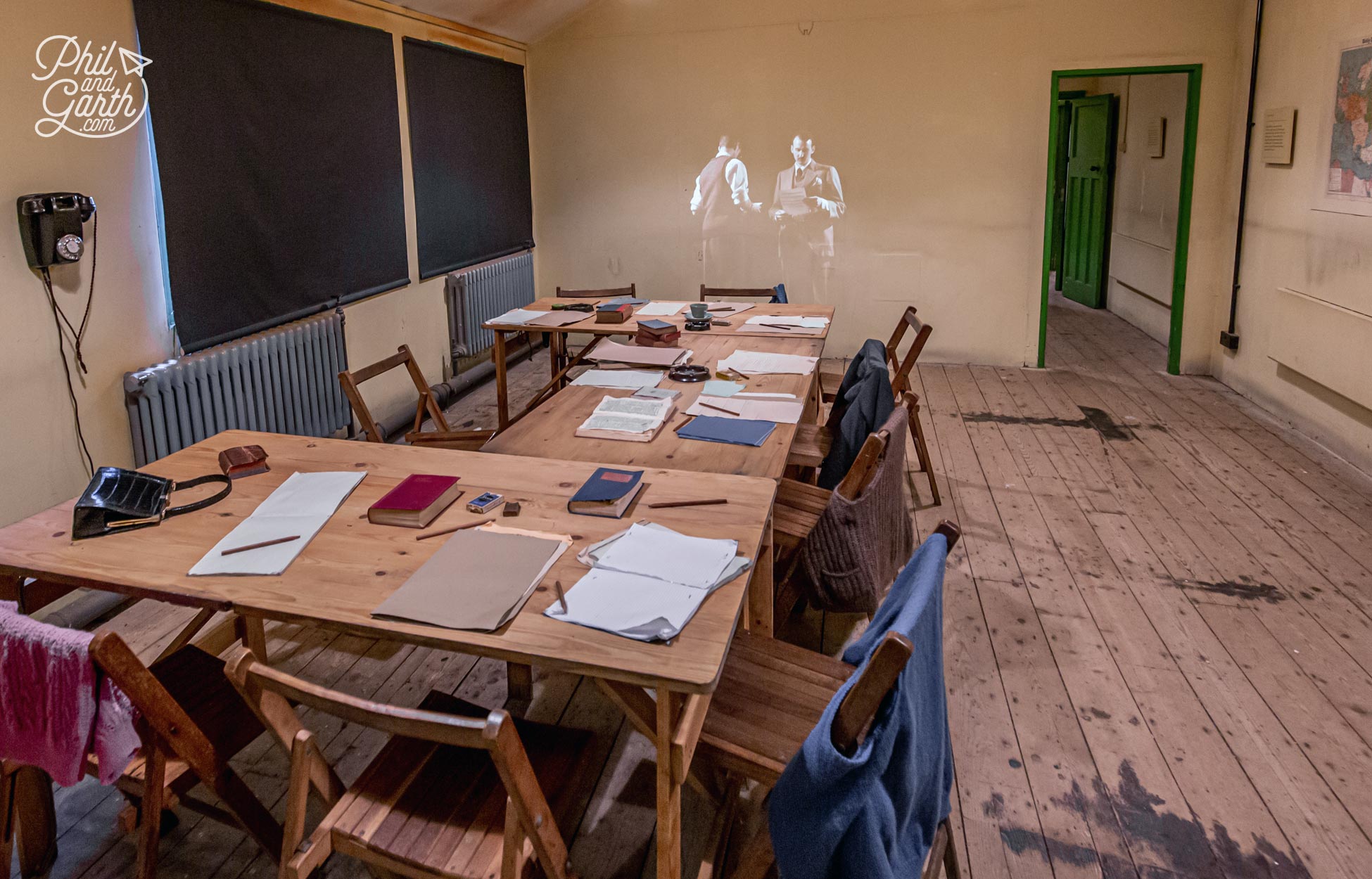
Video projections make the hut come to life
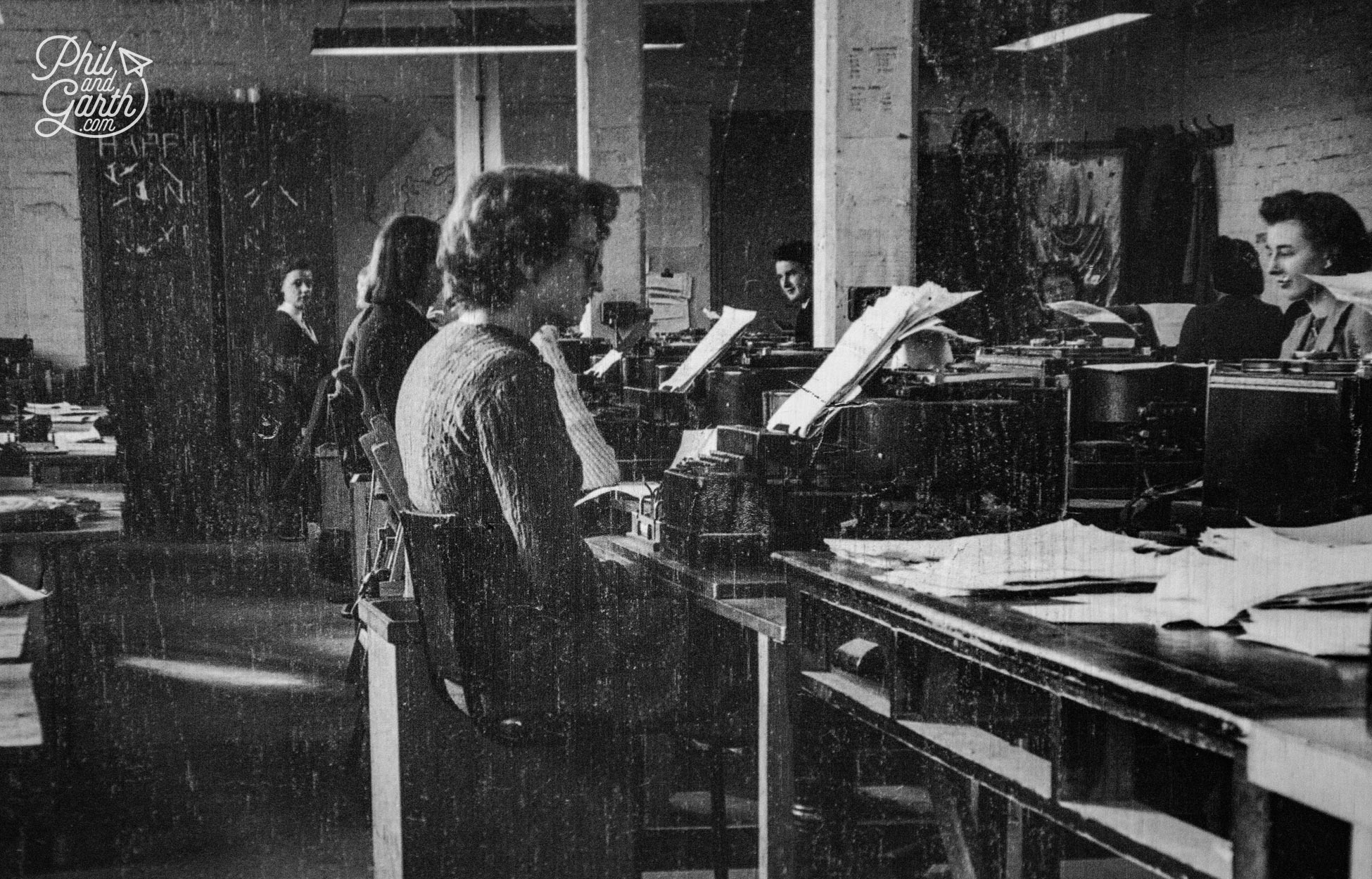
Inside Hut 6 staff deciphering messages on Typex machines
Hut 8 – Alan Turing’s Office
Hut 8 is special as this is where mathematician genius Alan Turing had his office. It’s dressed as it would have been during the war even down to his mug tied to the radiator.
Alan Turing worked in here deciphering Naval messages that were sent to German U-boats. The German Navy used an even more complex Enigma machine that had 4 rotors to encrypt messages. He eventually cracked it with his team. The deciphered messages were then sent on to Hut 4.
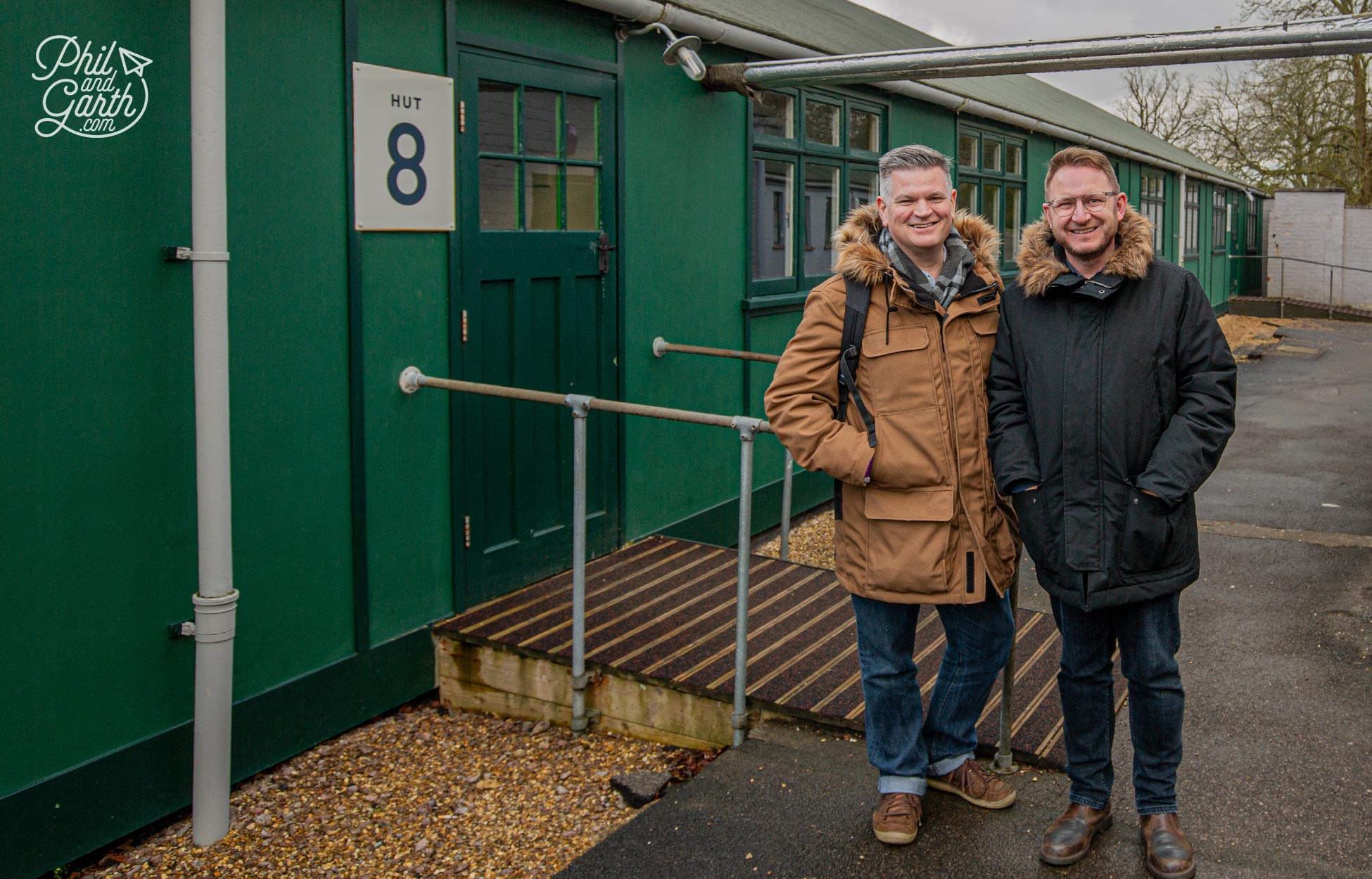
Phil and Garth outside Hut 8 where Alan Turing had his office
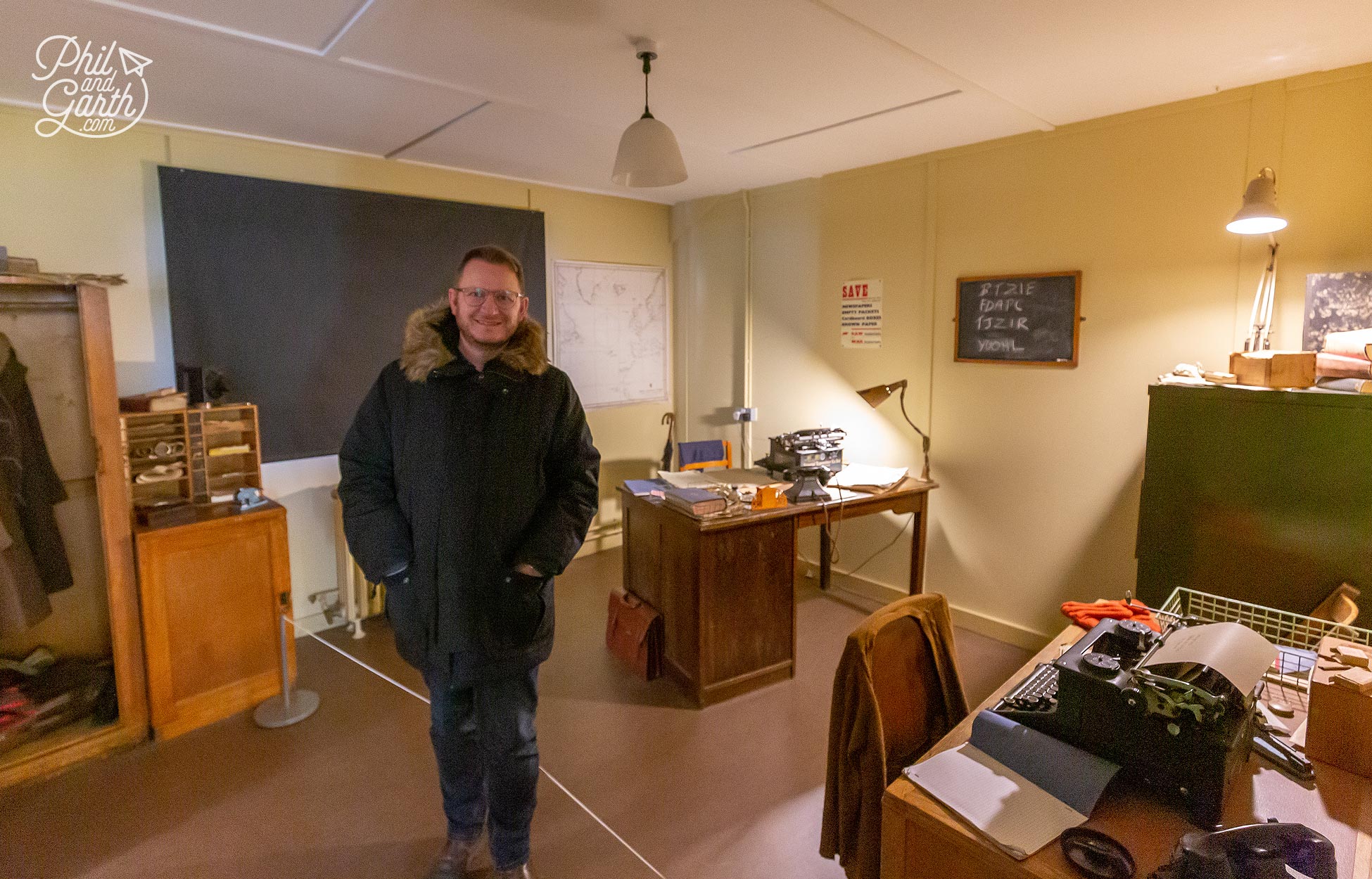
Garth inside Alan Turing’s office, Hut 8
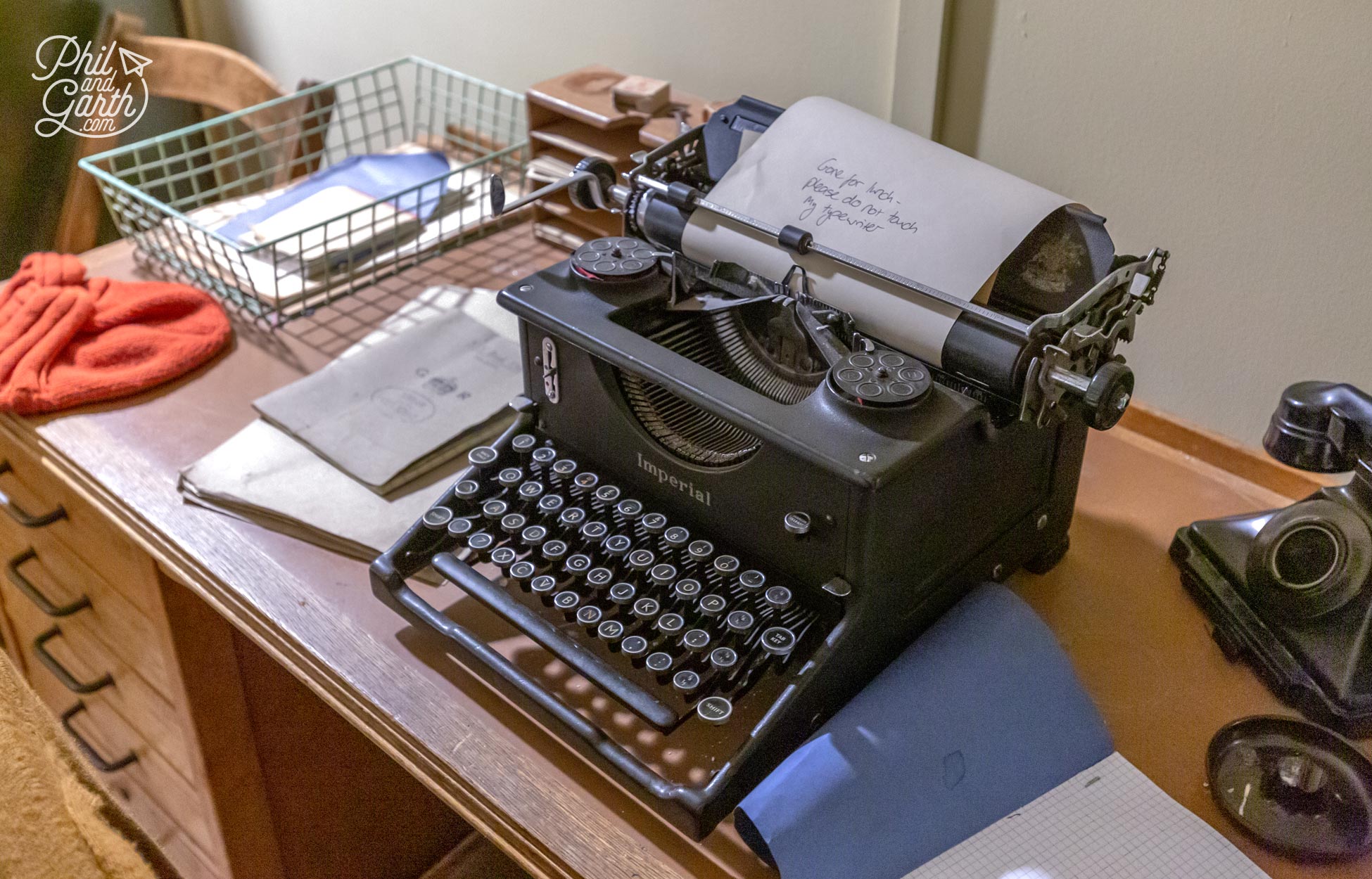
Perhaps this was his assistant’s desk?
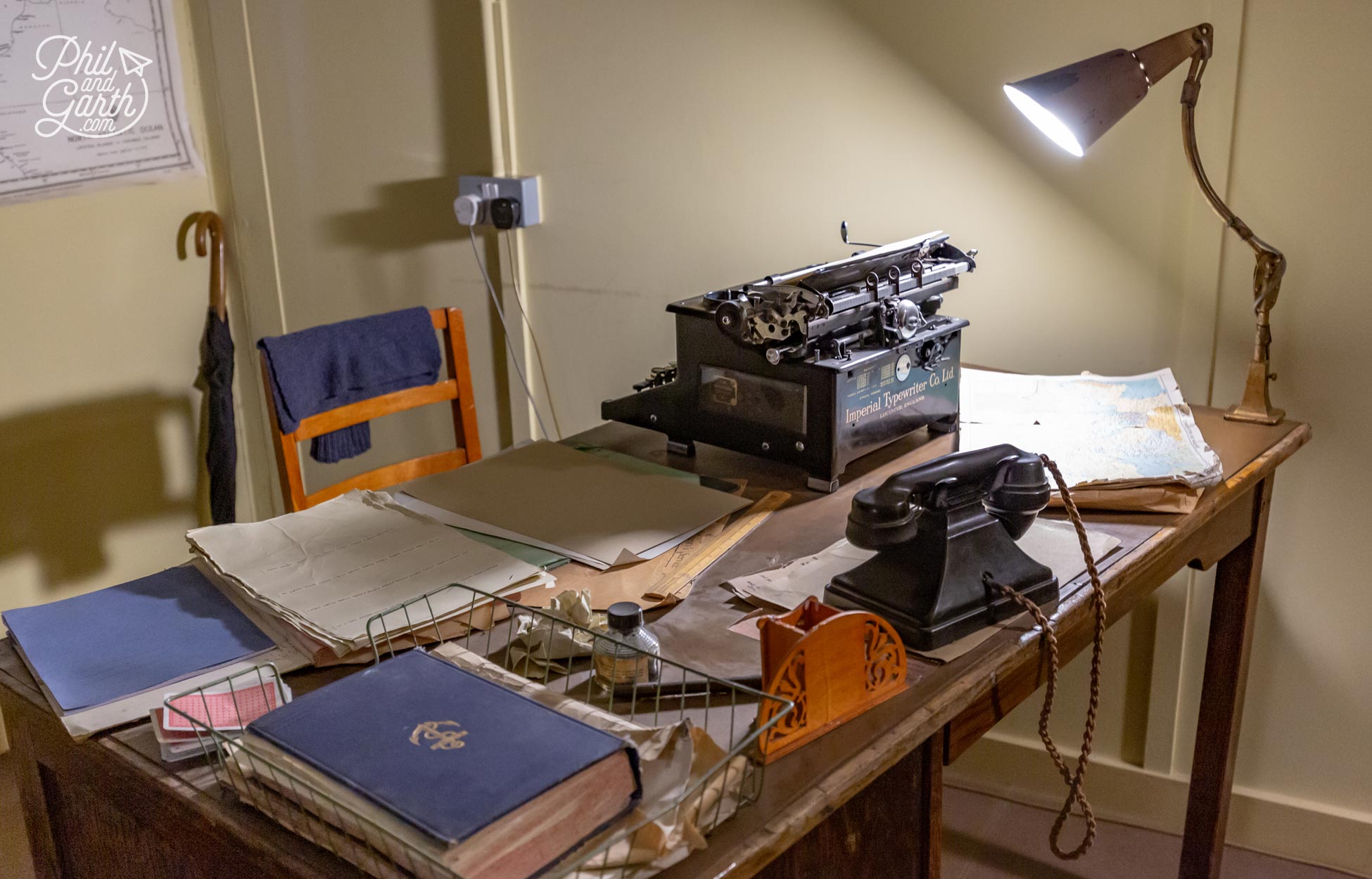
Alan Turing’s desk in his office
Alan Turing pioneered the world’s first computer at Bletchley Park and is widely considered to be the father of artificial intelligence. The saddest part of his life story is that he was convicted of gross indecency in 1952 and sentenced to chemical castration for being gay. He committed suicide 2 years later. In 2004 the UK government issued a posthumous apology to him and thousands of gay men under a Royal pardon scrapping their criminal records. Alan Turing now features on the back of the £50 bank note.
He was born in London, but lived in Manchester where we sat next to him – at a statue honouring his achievements. You can see and read much more about Turing in the Block-B museum.
Hut 11A – Bombe, The Codebreaking Machine
Inside Hut 11A is a re-creation of Alan Turing’s and Gordon Welchman’s Bombe machine. Looking at the machine and all the photographs we have no idea how it worked, it’s mind boggling clever. Even watching the introductory video left us both confused how it actually worked. To put it simply the Bombe machine was the equivalent of 36 Enigma machines wired inside to match the German machine … nope still don’t understand!
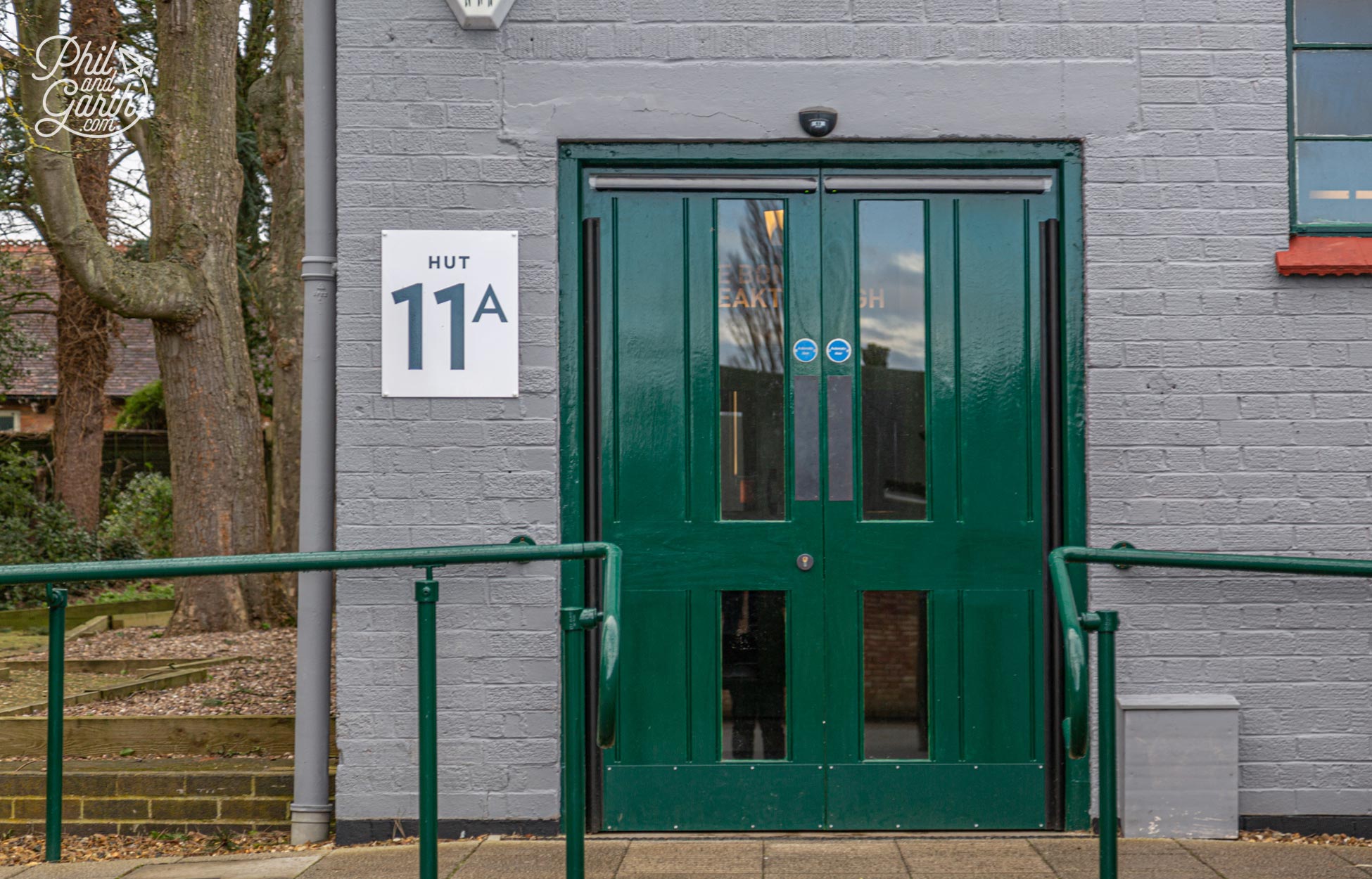
Hut 11A has an exhibition all about the Bombe machine
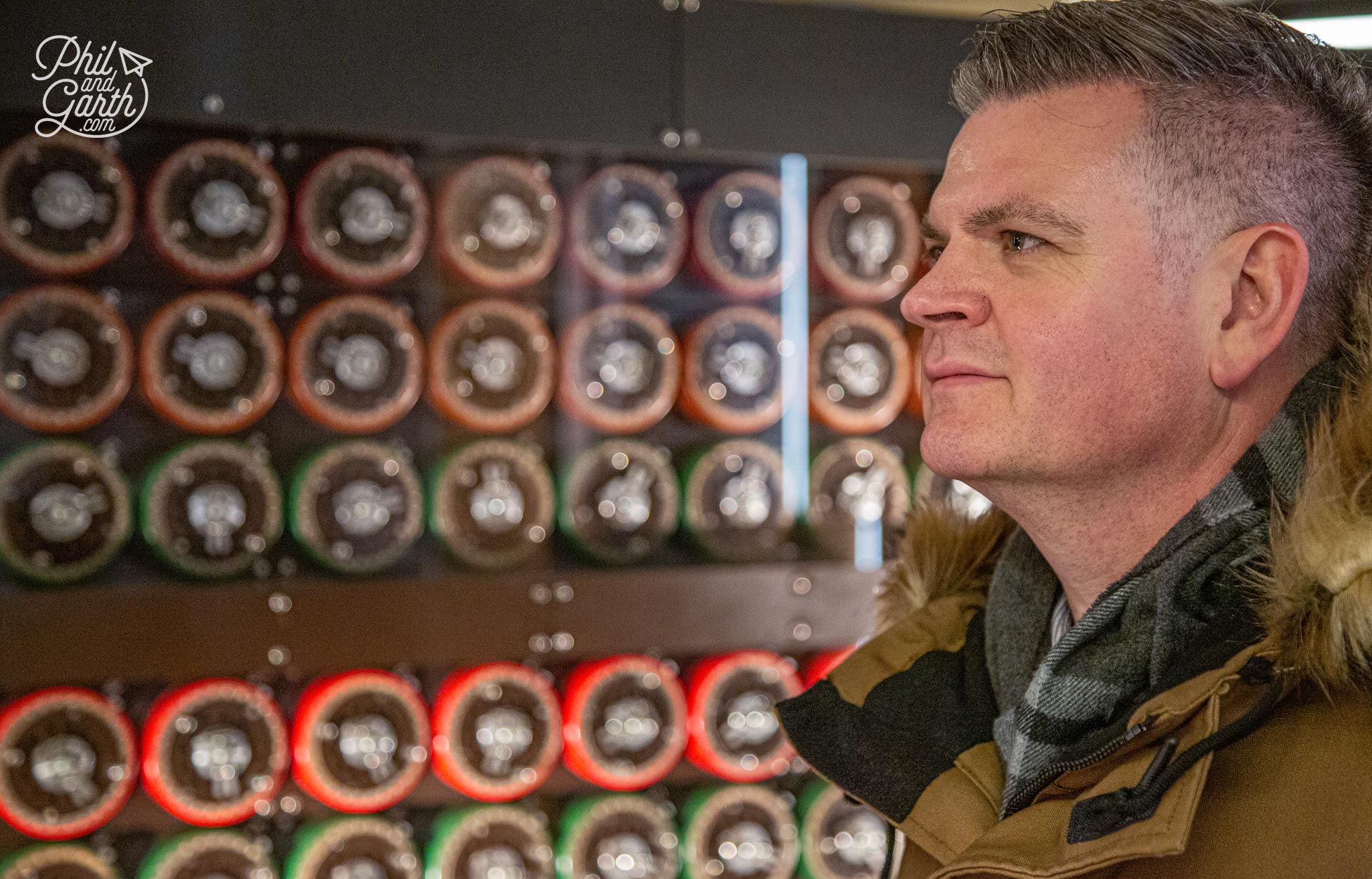
Phil stood next to a recreation of Turing’s Bombe machine
The machine had 12 miles of wires and the prototype cost a lot! in today’s money £4 million to build one. In total 211 Bombe machines were made. To prevent these expensive machines from being destroyed in one bomb strike they were installed in different locations across the UK, clever.
Hut 11 – The Bombe Codebreaking Factory
From 11A we walked into Hut 11 next door. A reinforced bomb-proof building that housed the first Bombe machines, inside it’s dark and cold. Women from the WRENs (Women’s Royal Naval Service) worked in here around the clock and described it as “hellhole in summer” because it was hot, smelly from the machine oil, incredibly noisy and had no ventilation. 6 machines were used to decrypt 3,000 messages everyday. There’s no original Bombe machines in existence because they were all destroyed after the war ended for security – nobody was to know what happened at Bletchley Park.
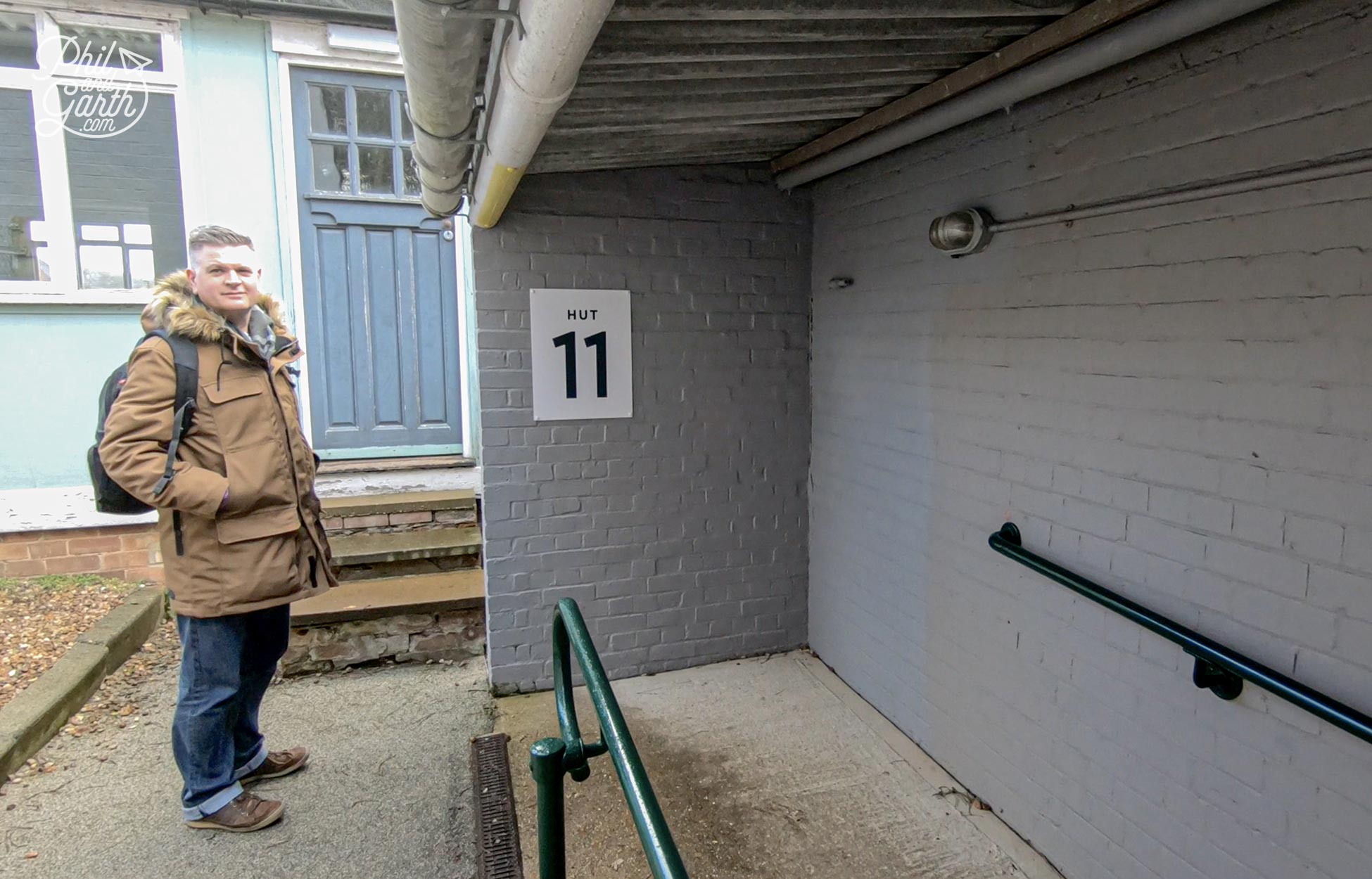
Phil outside Hut 11
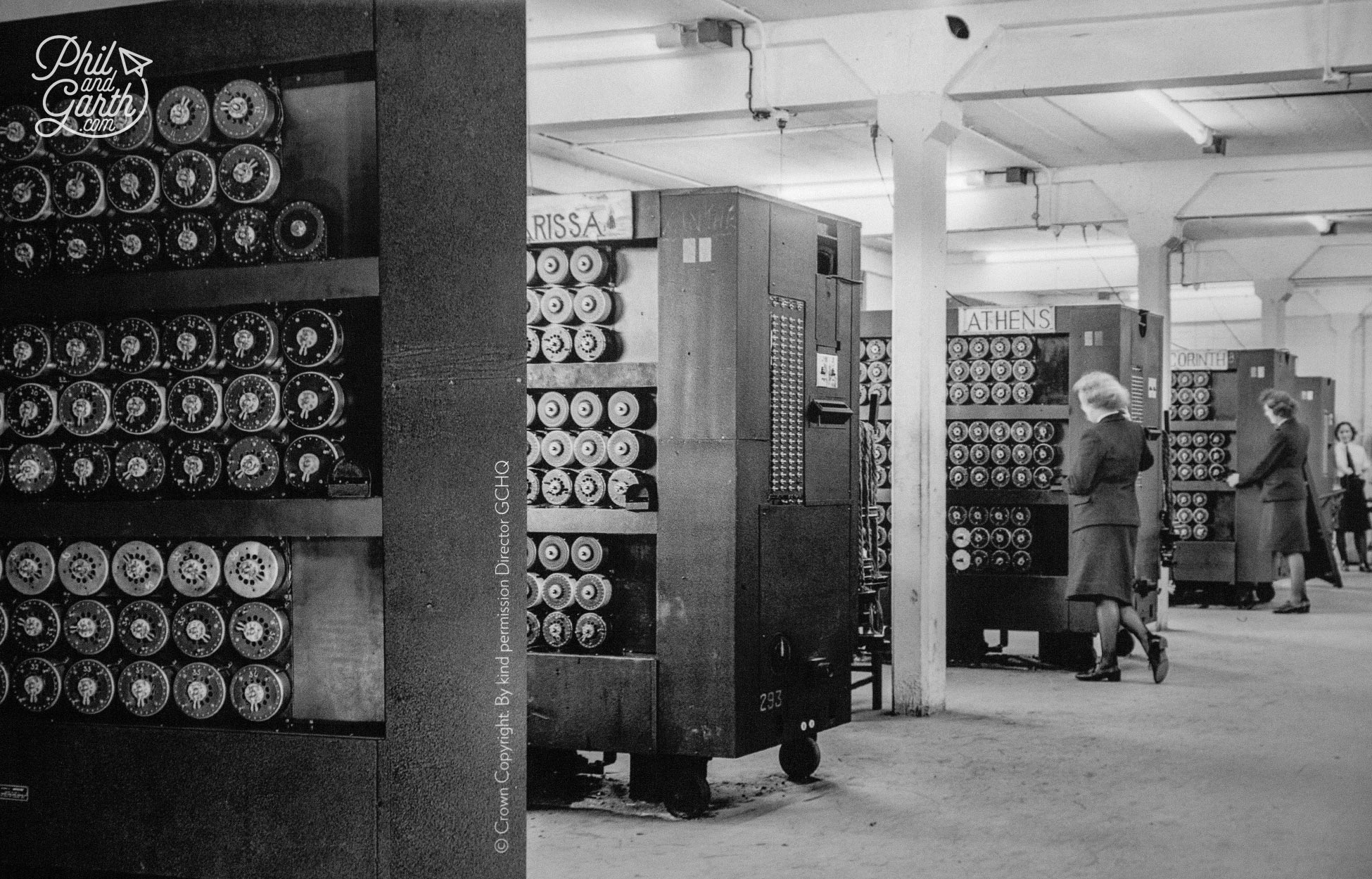
Inside Hut 11 which housed the first Bombe machines
Brick Built ‘Huts’
As the deciphering work load increased, new brick and concrete reinforced buildings were built to work alongside the wooden huts and used the same hut numbering system.
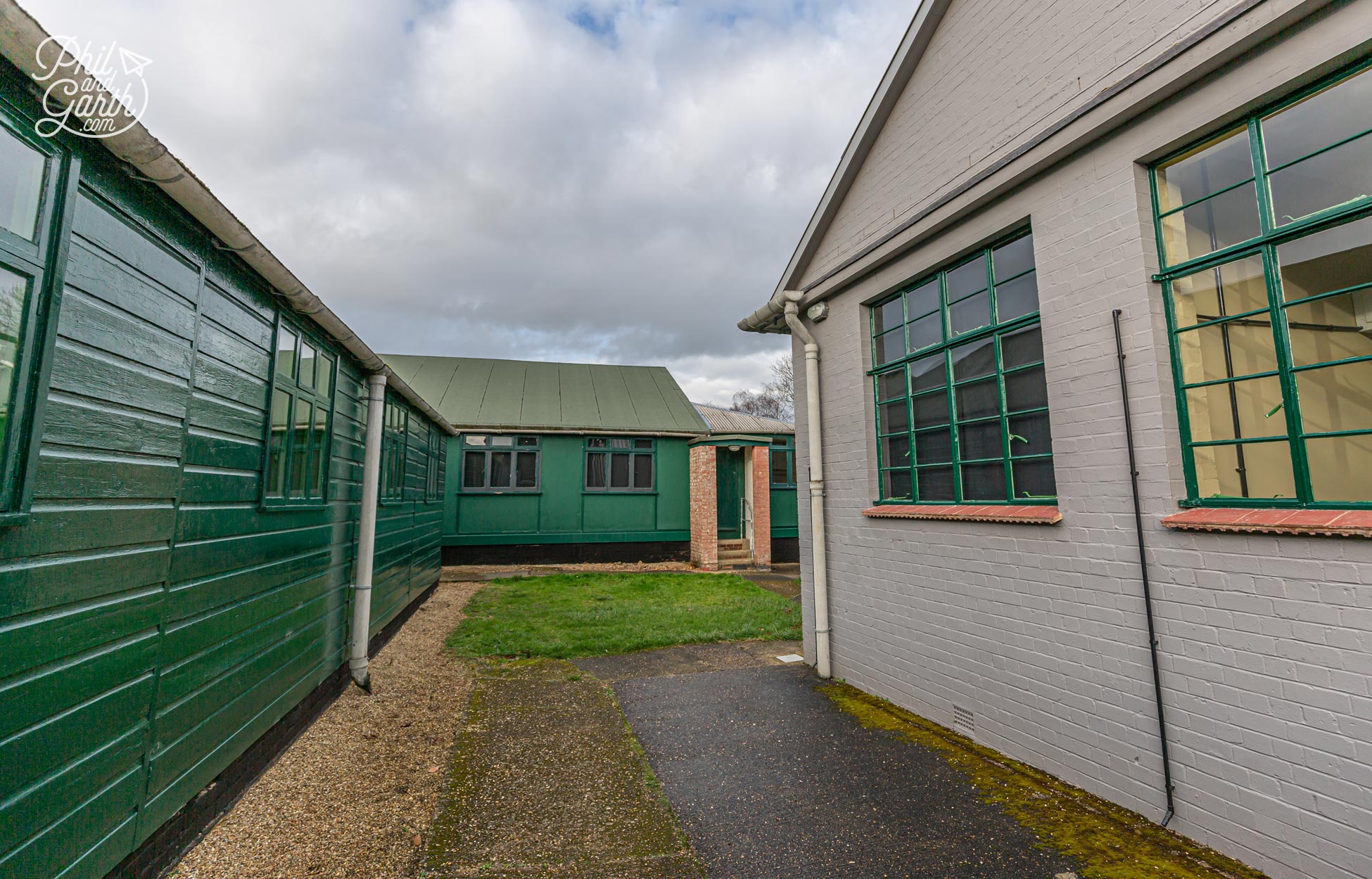
Bletchley Park built concrete and brick huts to house more codebreakers
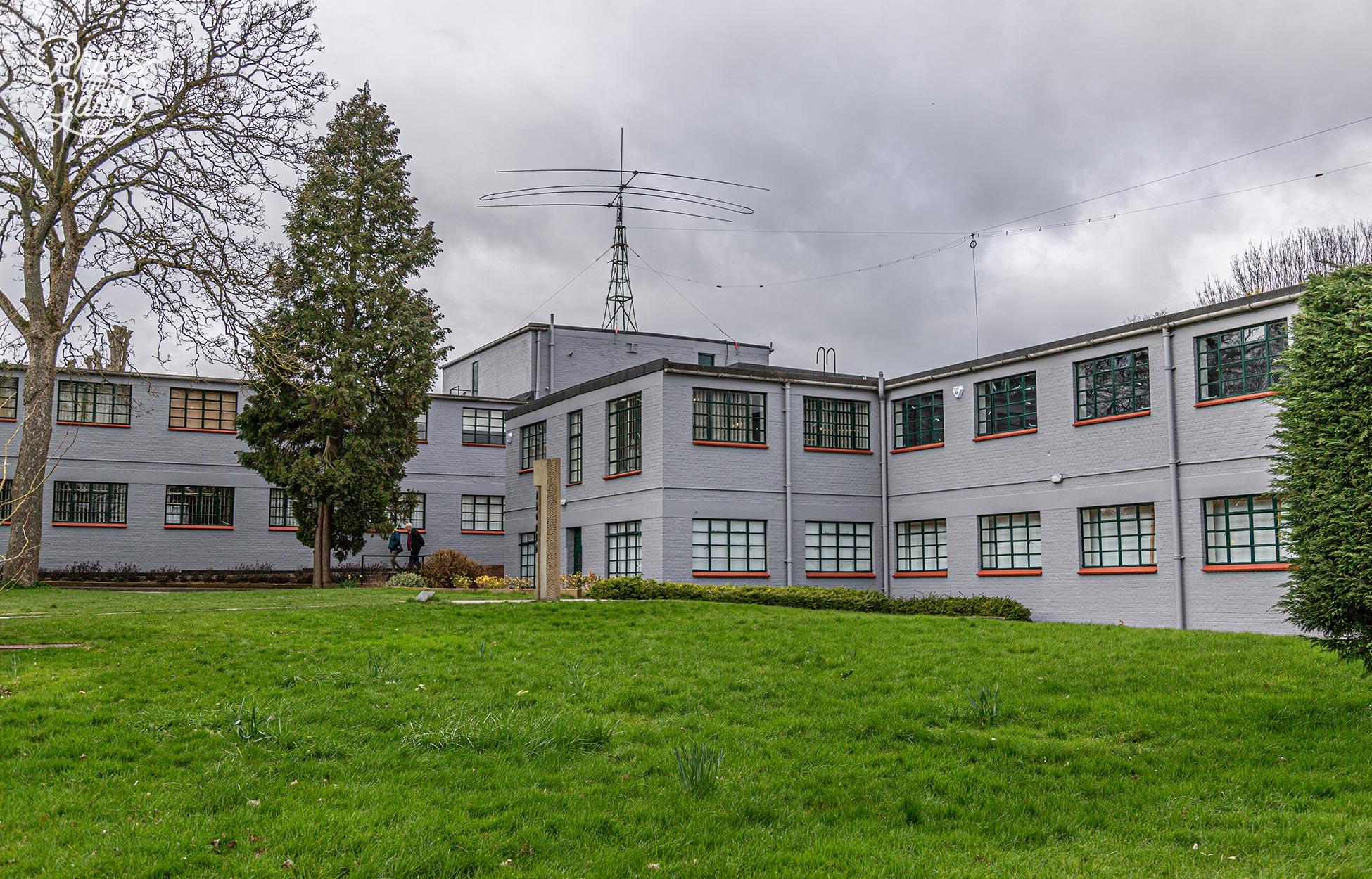
Block-B is now a museum and with the collection of Enigma machines
The Mansion
A couple of Griffin statues welcome us inside the Mansion which dates back to 1870. It served as the recreational building and housed offices for senior Military staff. Inside these offices there is a real war time feel. You are reminded by posters on the wall ‘Careless talk costs lives’.
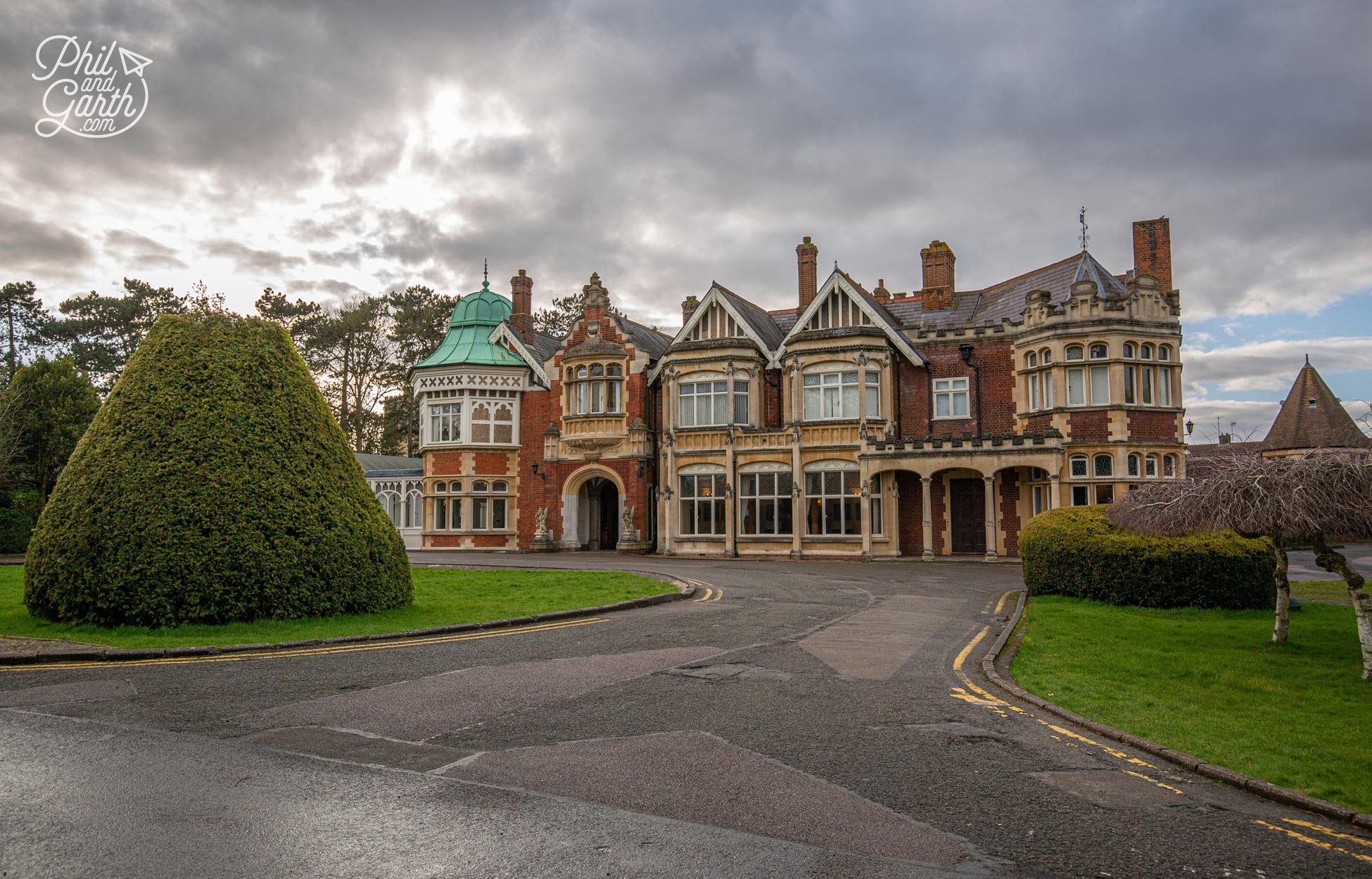
Pebbles in the grass around the Mansion represent where other huts used to be
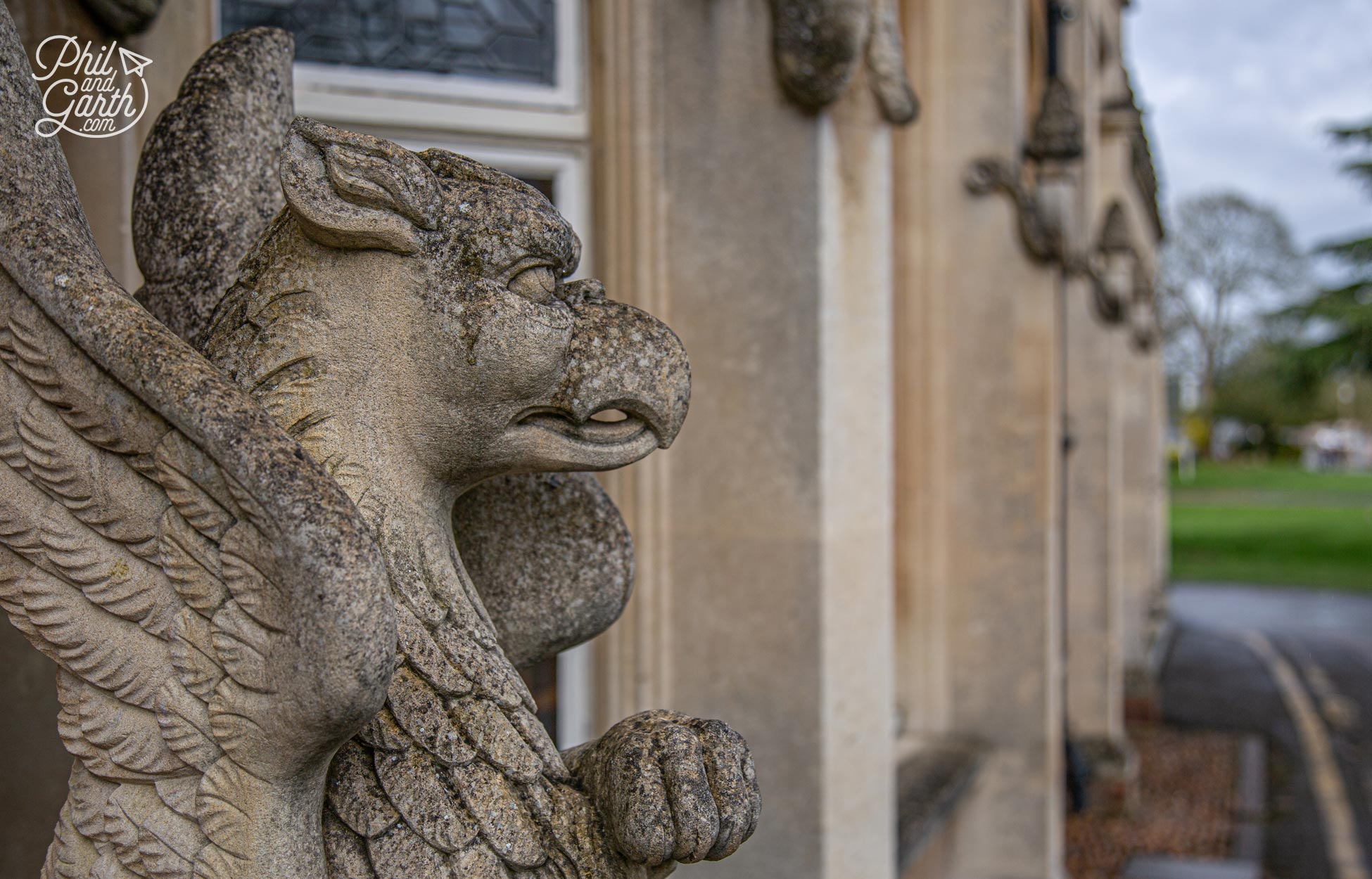
We loved these Griffin statues at the entrance
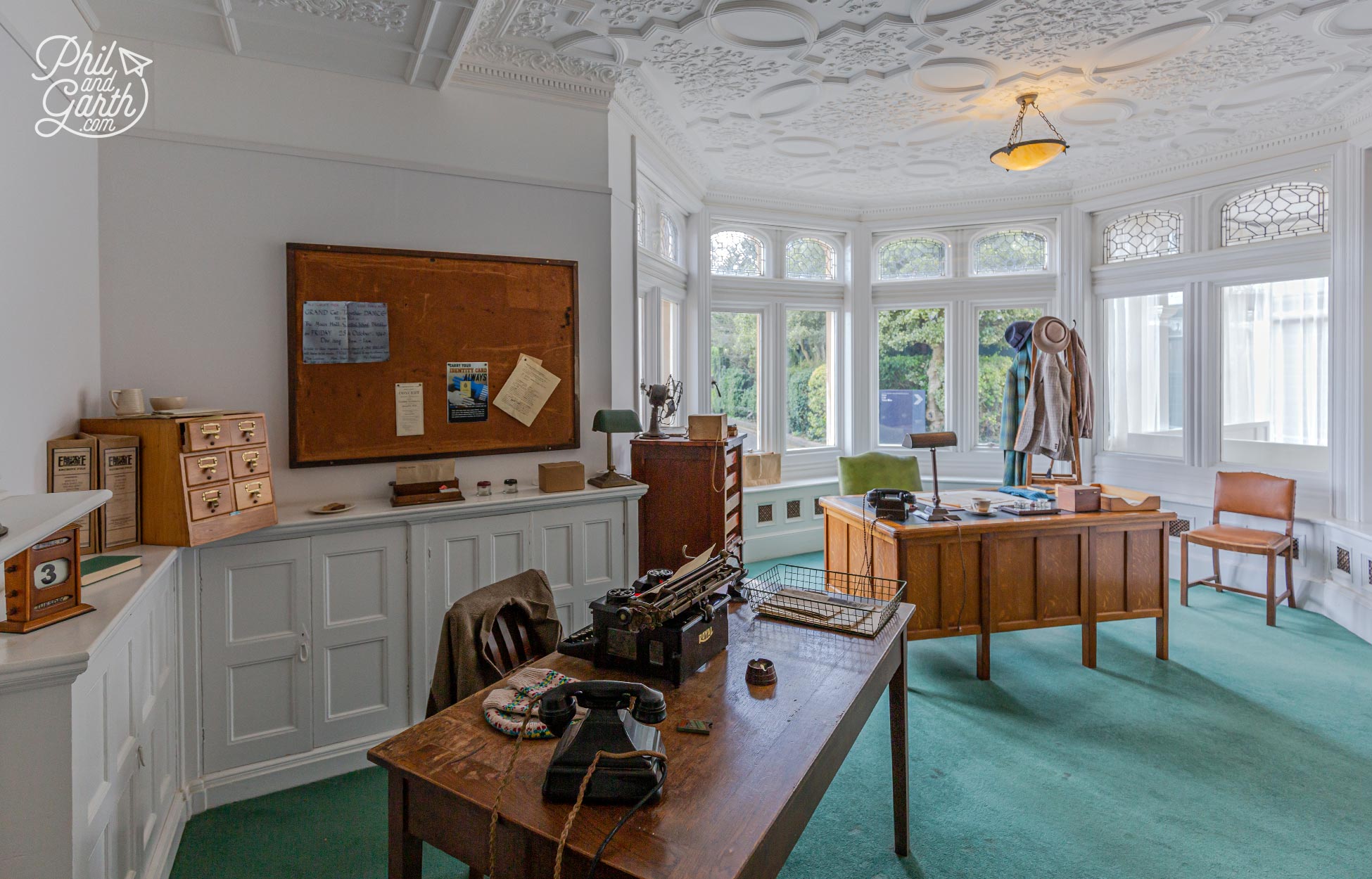
Commander Denniston’s Office inside the mansion
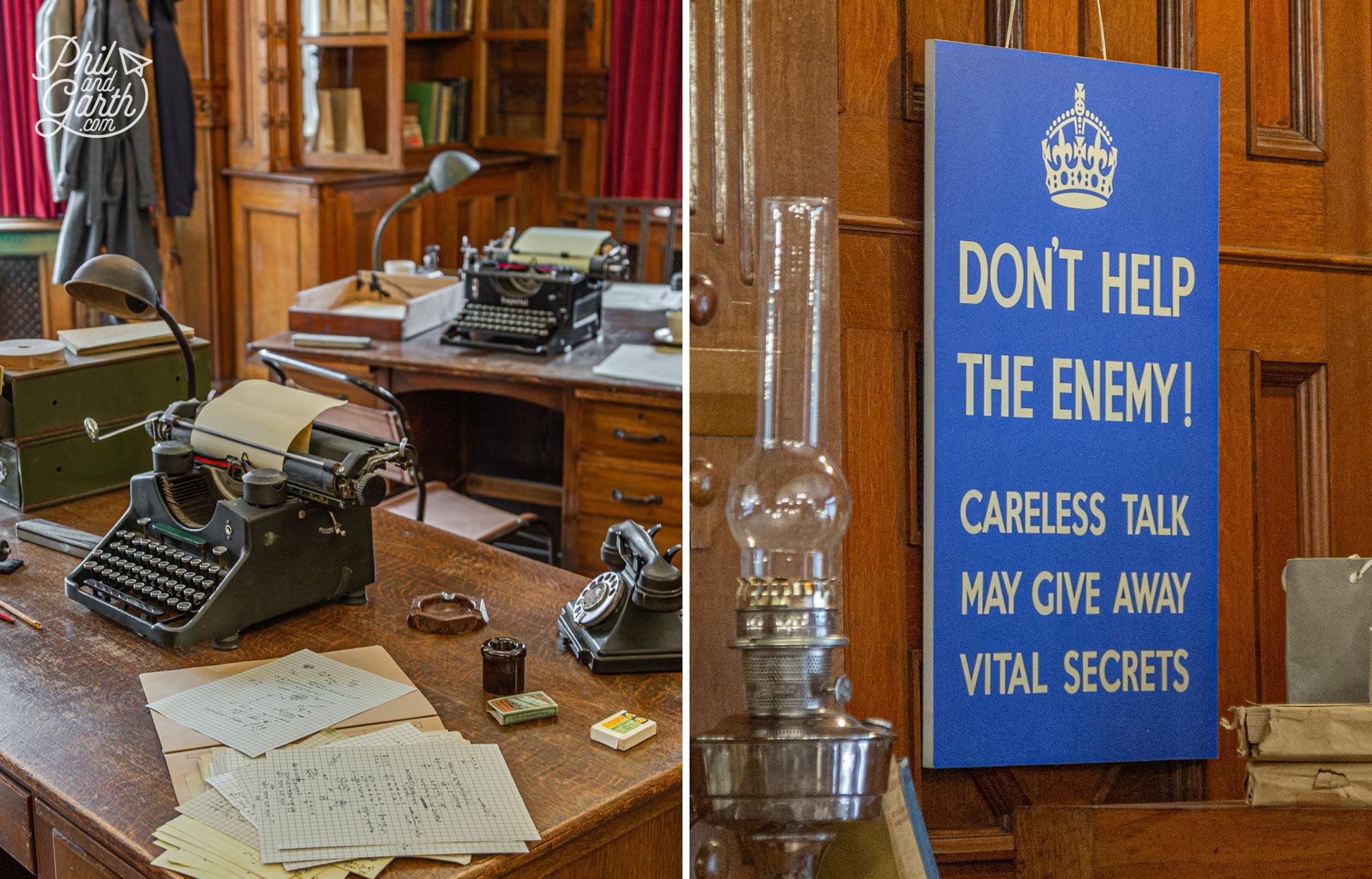
Don’t Help The Enemy!
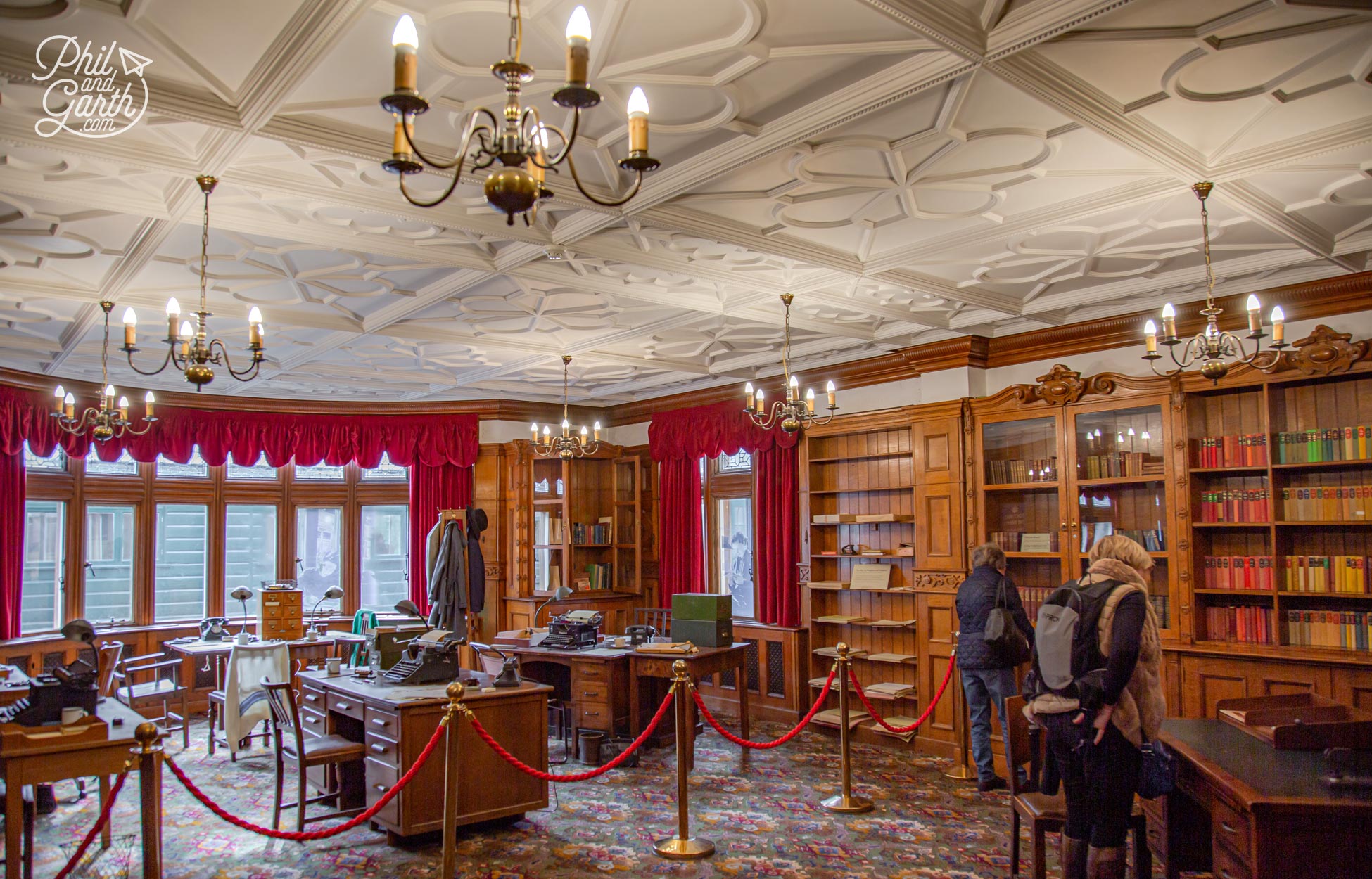
Inside the mansion there is a real war time feel
Outdoor Guided Tour
There are free one hour guided tours which you can book at the information desk. Our guide knew his stuff and was really informative and fun. He took us on an outdoor tour around the grounds.
At the back of the Mansion is a stable yard housing a small motor museum and a row of cottages. This is the location where the Enigma code was first broken in cottage No.3 by Alan Turing, Dilly Knox and John Jeffreys in 1940. Outside the cottage is a memorial to 3 Polish mathematicians who helped them crack Enigma.
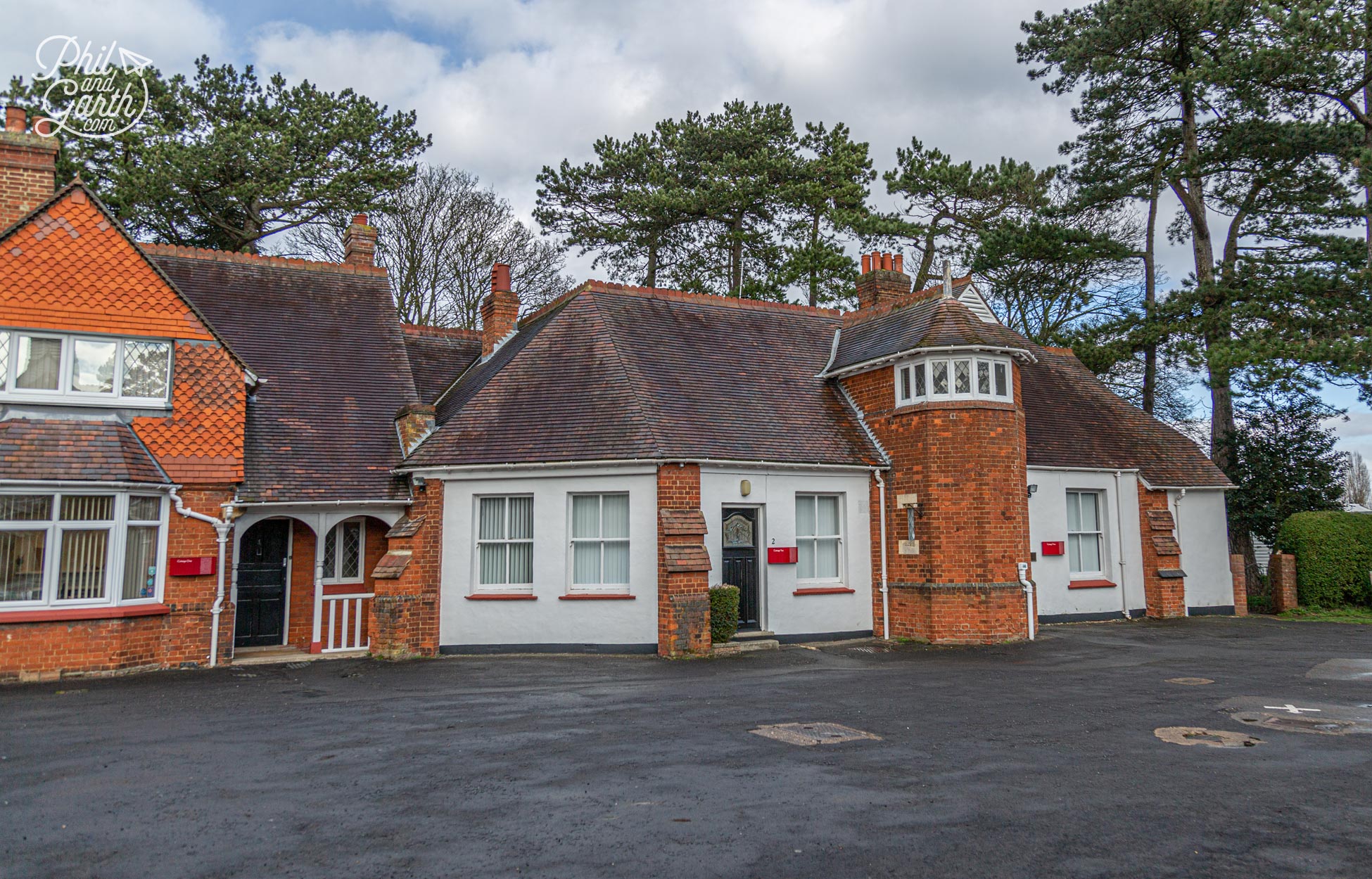
Cottage Number 3 where the Enigma code was broken
We asked our guide if the locals ever got suspicious about the activity at Bletchley Park? He explained locals didn’t gossip about people coming in and going out of Bletchley. People didn’t question authority in those days of war.
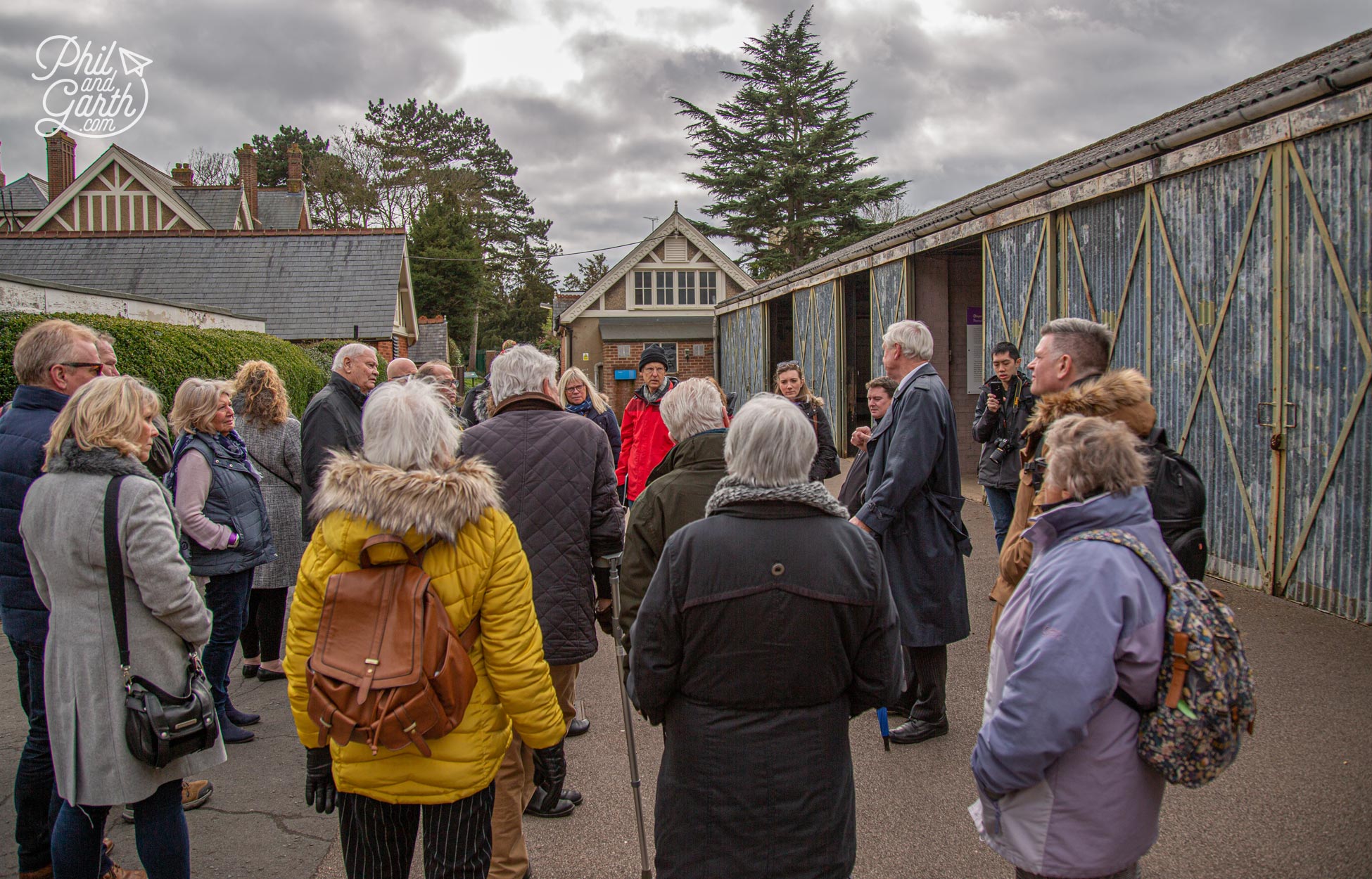
Our guide answers questions at the back of the Mansion
He also told us some great tales about the many romances that started here who went onto marry. Plus stories of the recreation activities such as chess clubs, Scottish dancing, drama groups. People would also go skating on the frozen lake in Winter. Bletchley also had tennis courts and a croquet lawn. We thought Bletchley Park sounded just like one big university campus.
If you don’t have time to book on a guided tour, then use the free multimedia guide instead. You can collect one on the way outside from the Visitors Centre, there’s also a version for children.
D-Day – Deceiving the Nazis
The last exhibition we visited was one of our favourites. D-Day ‘Interception, Intelligence, Invasion’ is an impressive cinematic experience which lasts about 10 minutes. It tells the story of the codebreakers role for D-Day – the largest seaborne invasion in history.
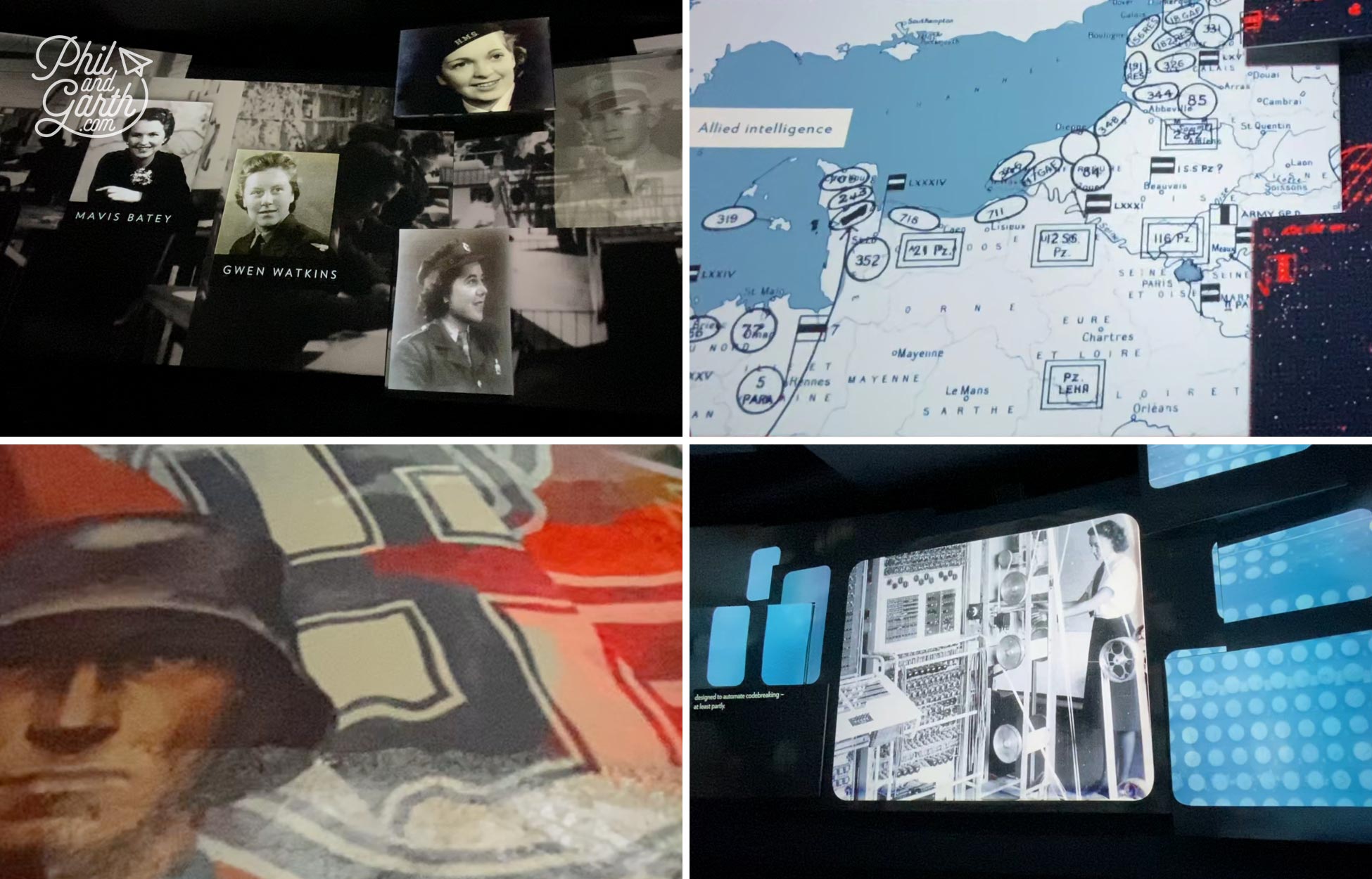
Images from the brilliant D-Day ‘Interception, Intelligence, Invasion’ exhibition
After the success of the Bombe code breaking machine, Bletchley had now invented Colossus. The world’s first programmable computer designed to decipher German Lorenz machines. Much more complex than Enigma, Lorenz machines had 12 encryption rotors. They were used for top communications between German High Commanders and Hitler throughout Nazi occupied Europe. By breaking into these high level messages, Bletchley gave the Allies (Britain, USA, Canada, France) vital intelligence. Used to build up a picture of Hitler’s fortresses across France and Europe in preparation for D-Day.
The D-Day deception plan was made. A sophisticated hoax to convince the Nazis that the Allies were going to invade Calais in France instead of of the real location – Normandy. Bletchley monitored German messages to make sure the fake reports and deception messages were working. The German’s fell for it.
On 6 June 1944 the Normandy Invasion began and for the most part it worked. By the end of D-Day 150,000 soldiers had successfully landed in Normandy. Bletchley’s codebreakers were now intercepting, decrypting and translating messages in as little as 2 1/2 hours. Their speedy intelligence work is considered to have saved countless lives of many British and American soldiers.
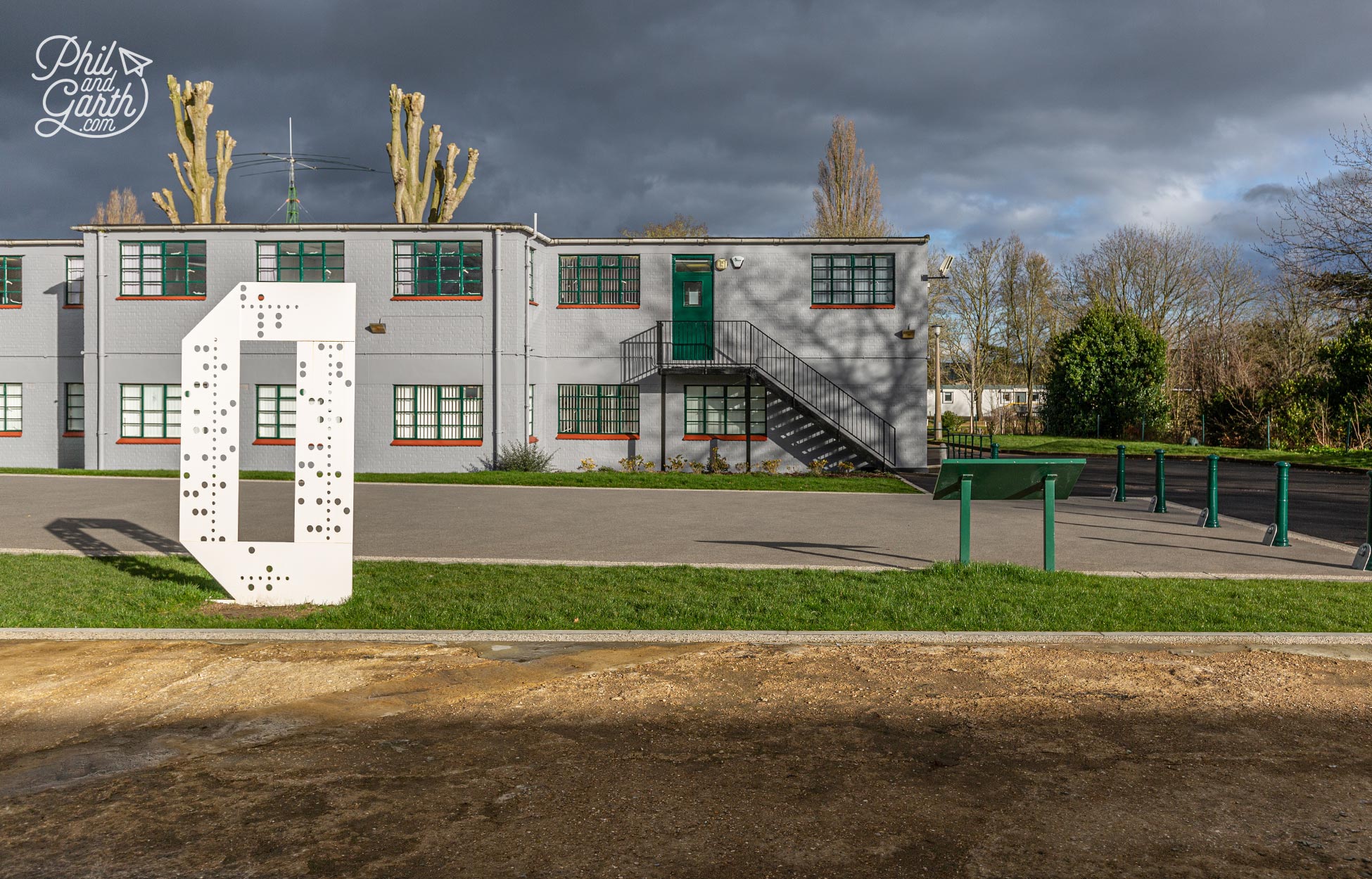
‘D’ in D-Day stands for ‘day’ – the term was used to describe the first day of any large military operation
Souvenir Shop
A quick mention about their shop – it’s amazing for British themed gifts and. We stocked up on a few Christmas presents for friends.
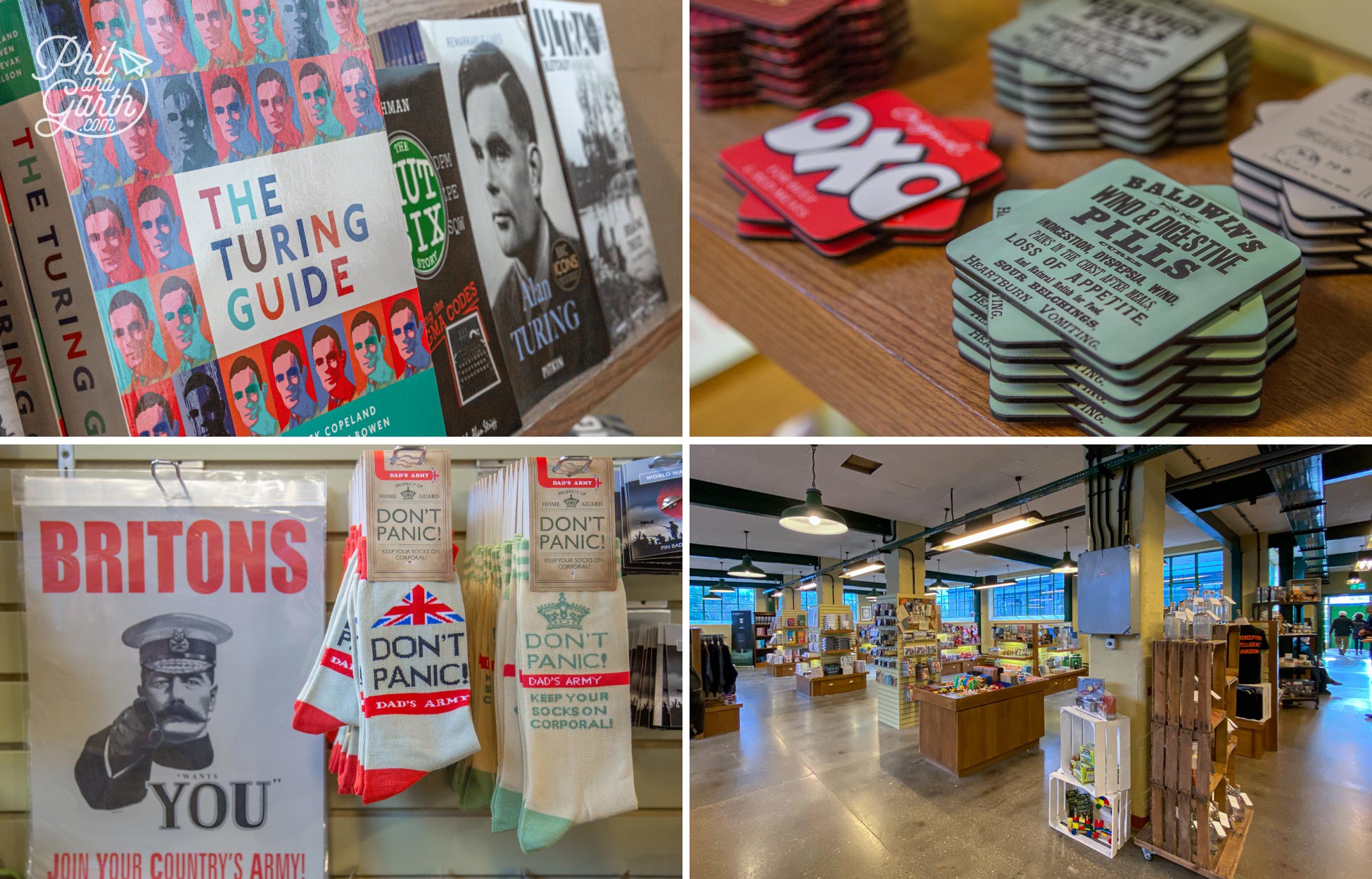
Visit Bletchley Park’s shop for war themed gifts
Bletchley Park Is A Great Day Out!
We’re not big museum fans, however we thought Bletchley Park was brilliant – it’s educational, but not boring. The time flew by and we learnt so much! The stories and mystery about Bletchley Park give it a sense of magic. There must be so many more unsung heroes and more secrets to be told.
Visiting Bletchley Park – Practical & Useful Information
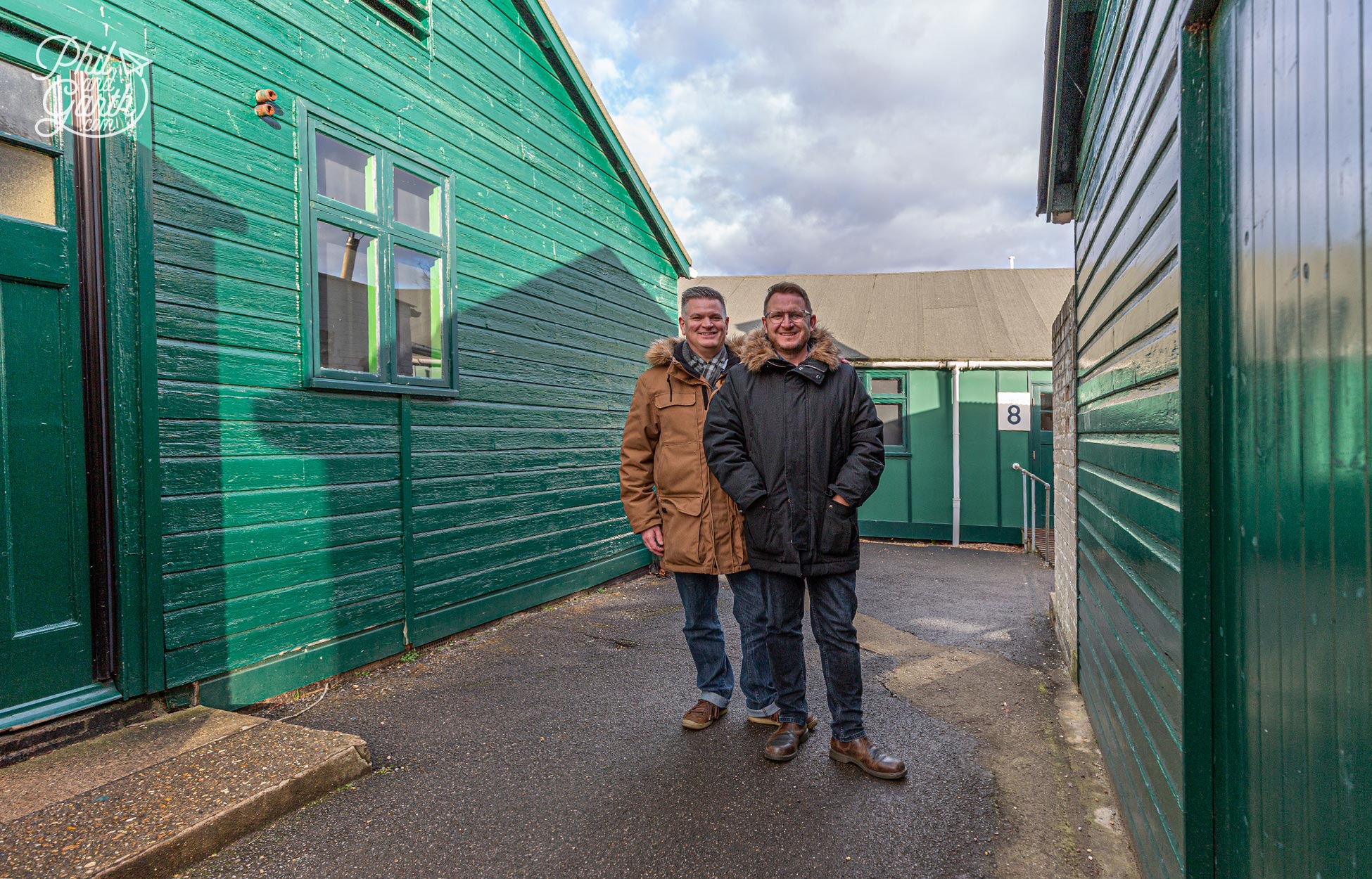
Visit Bletchley Park – Phil and Garth’s Top 5 Tips
Phil and Garth’s Top 5 Bletchley Park Tips
- Tip #1: Book the free guided tour as soon as you arrive. Tours meet inside the chauffeur hut.
- Tip #2: Watch 2 movies – ‘The Imitation Game’ (2014) or ‘Enigma’ (2001) or the ITV tv series ‘The Bletchley Circle’.
- Tip #3: Take an umbrella for the outdoor guided tour.
- Tip #4: Spend the next day visiting the The National Museum of Computing museum. It’s located inside Bletchley Park.
- Tip #5: The cafe is expensive, so you might want to take your own packed lunch with you.
Visit Bletchley Park – The Costs
- We paid £20 each for an adult ticket. Yes it’s expensive, but worth it. Family tickets cost £52 / Children 12-17 £12 / Under 12 free. You can get it slightly cheaper by booking ahead online on their website. The entry ticket lasts 1 year for unlimited visits.
Getting To Bletchley Park, Milton Keynes
- Bletchley Park is just an hour from London by train and a 5 minute walk from Bletchley Park train station, so is a good option if you’re looking for a day trip from London.
Where We Stayed
- We had a fab stay in a shepherd’s hut for the night – an AirBnB in Milton Keynes.






